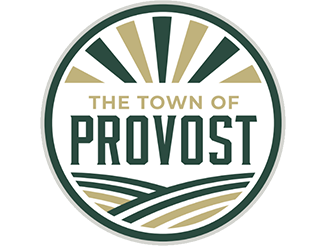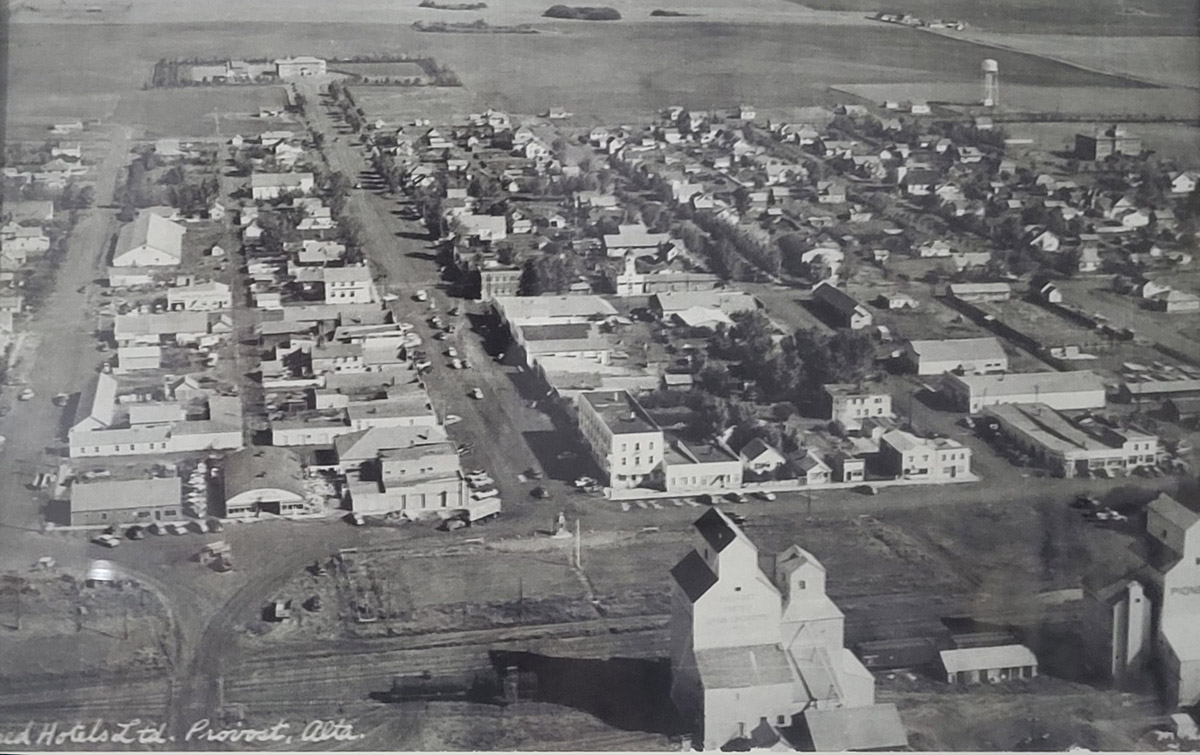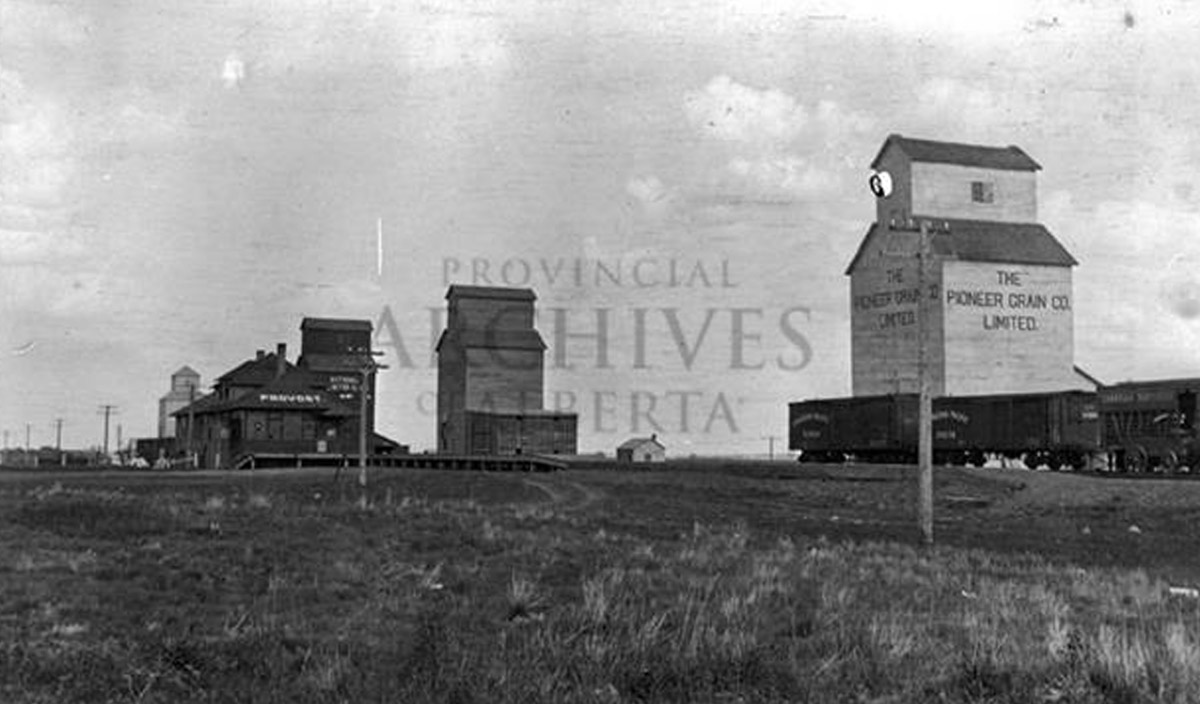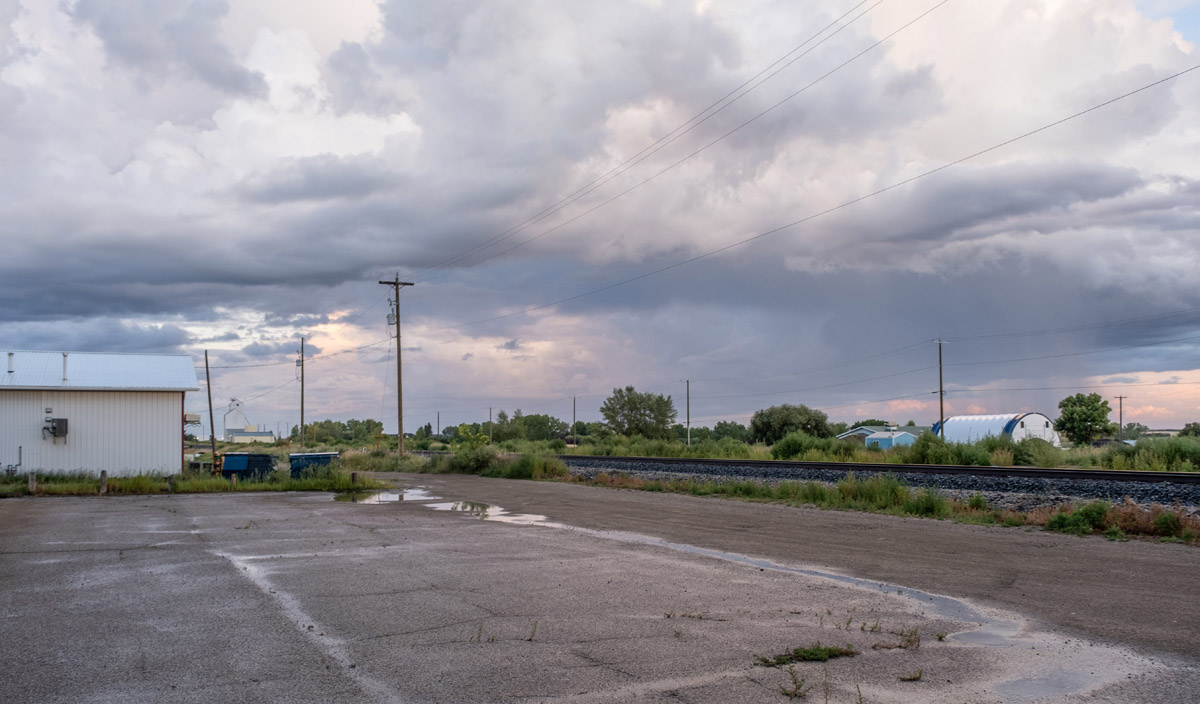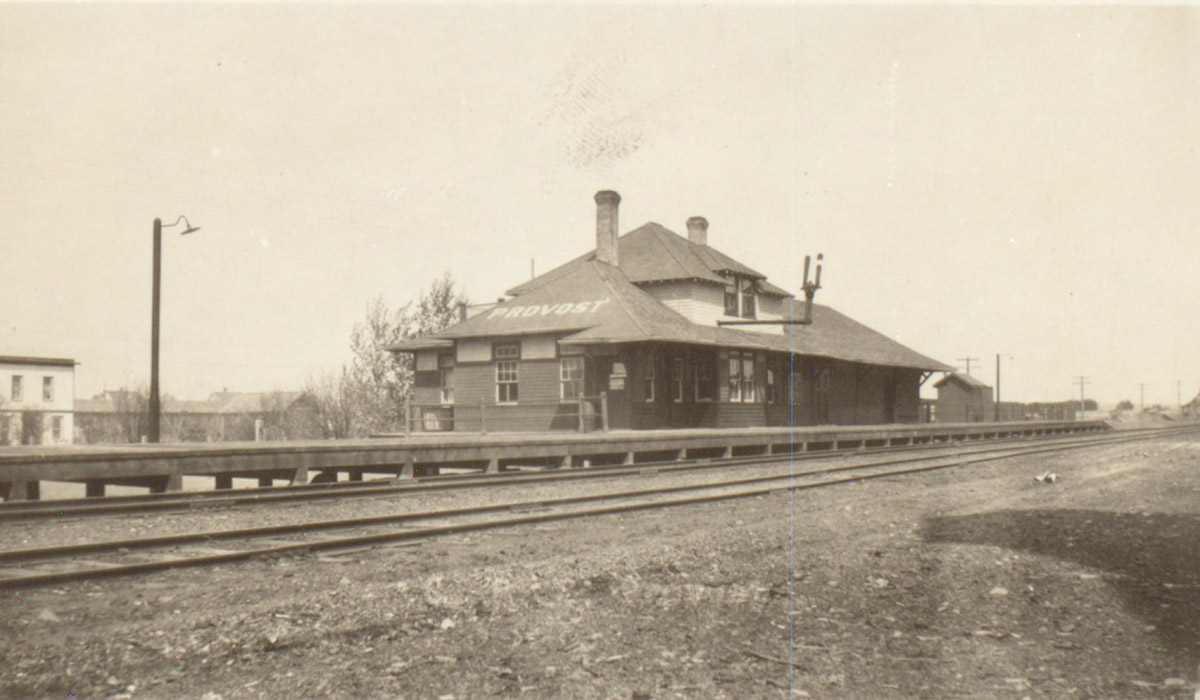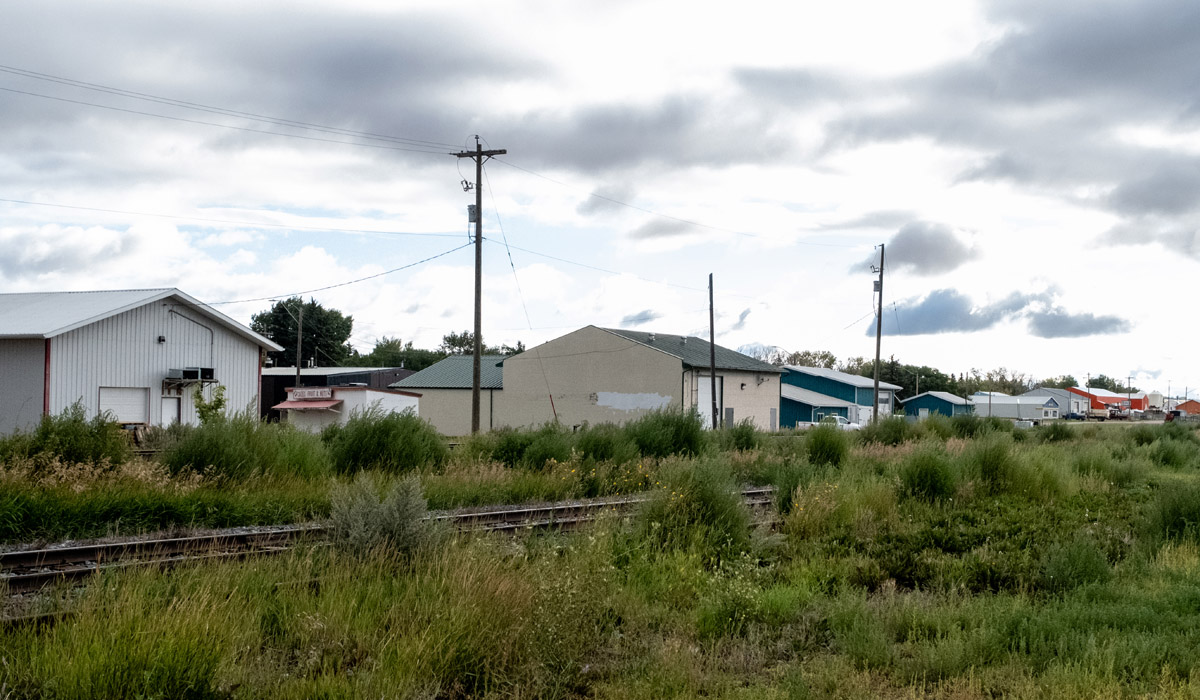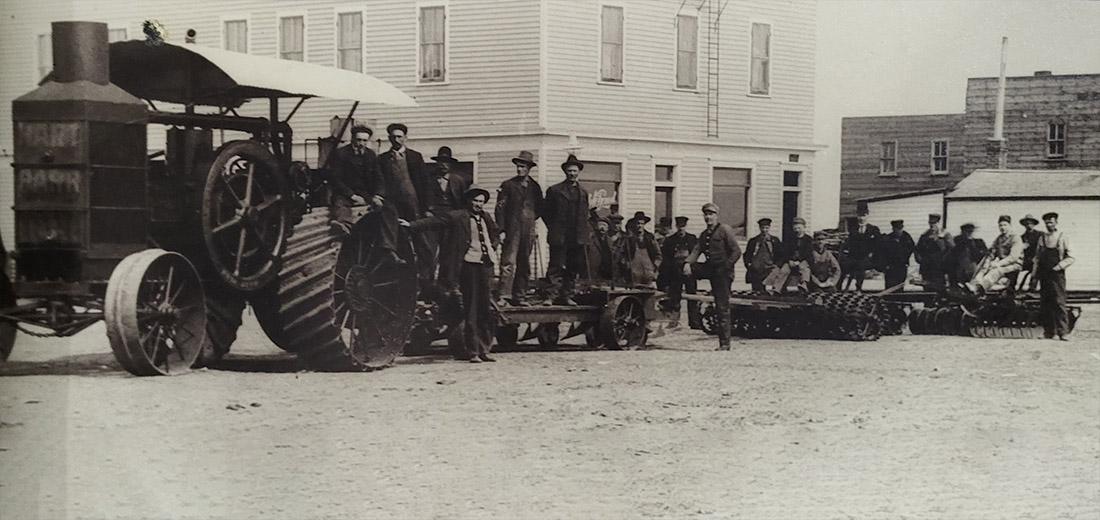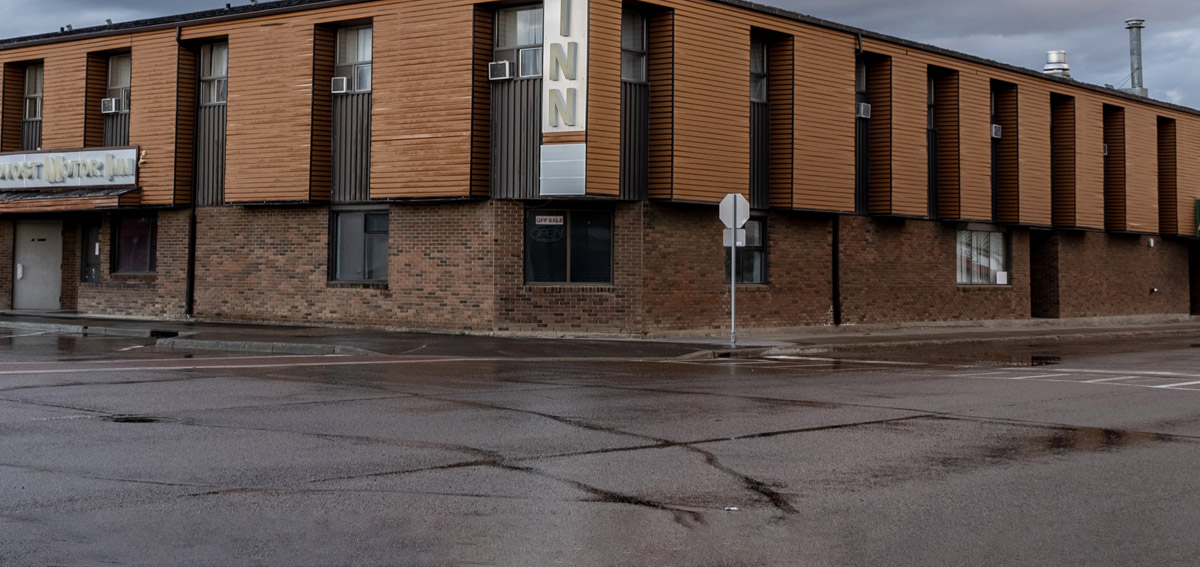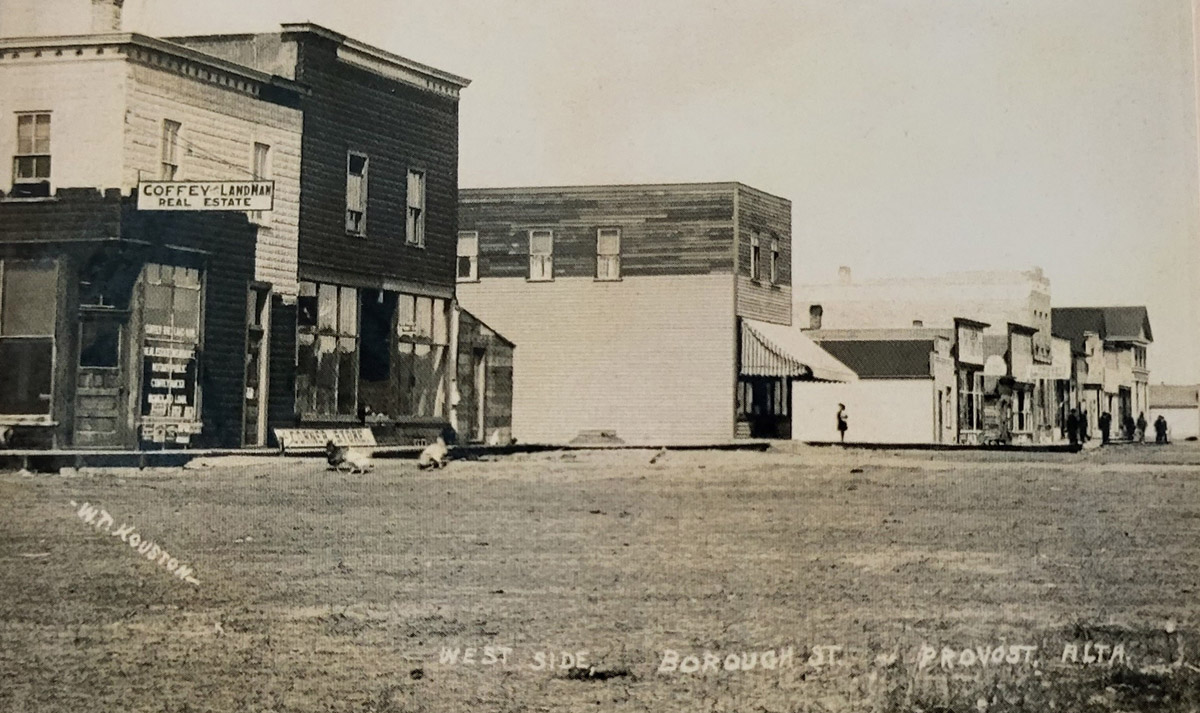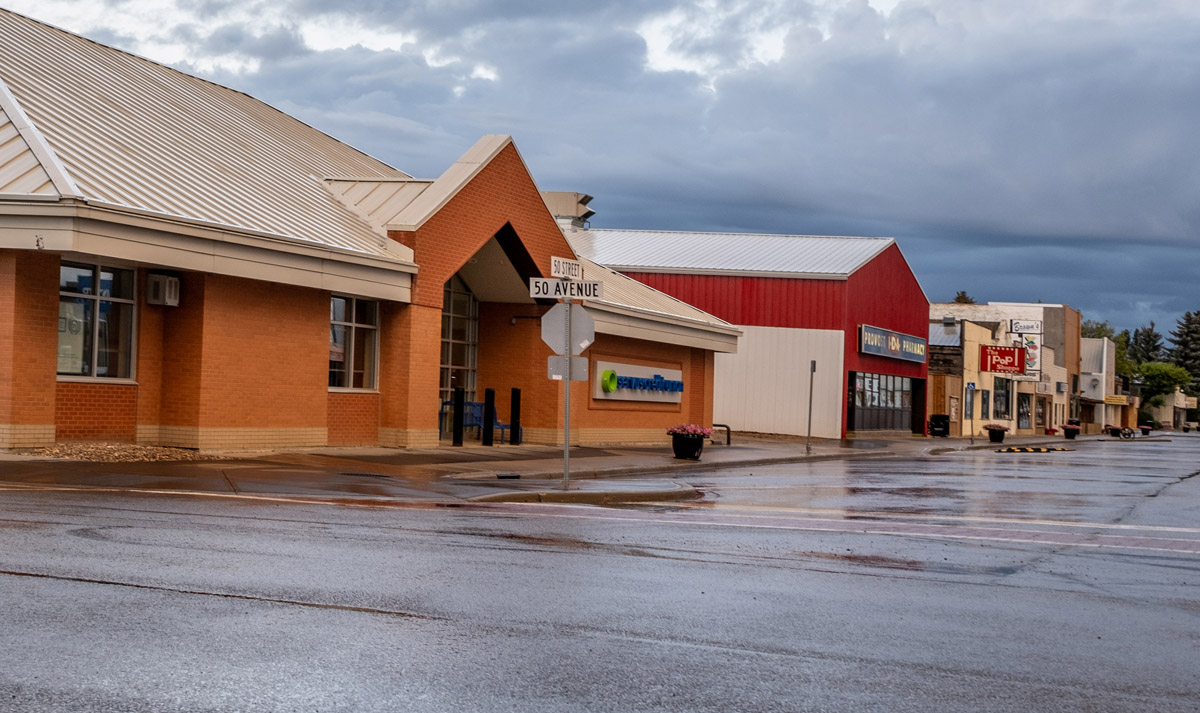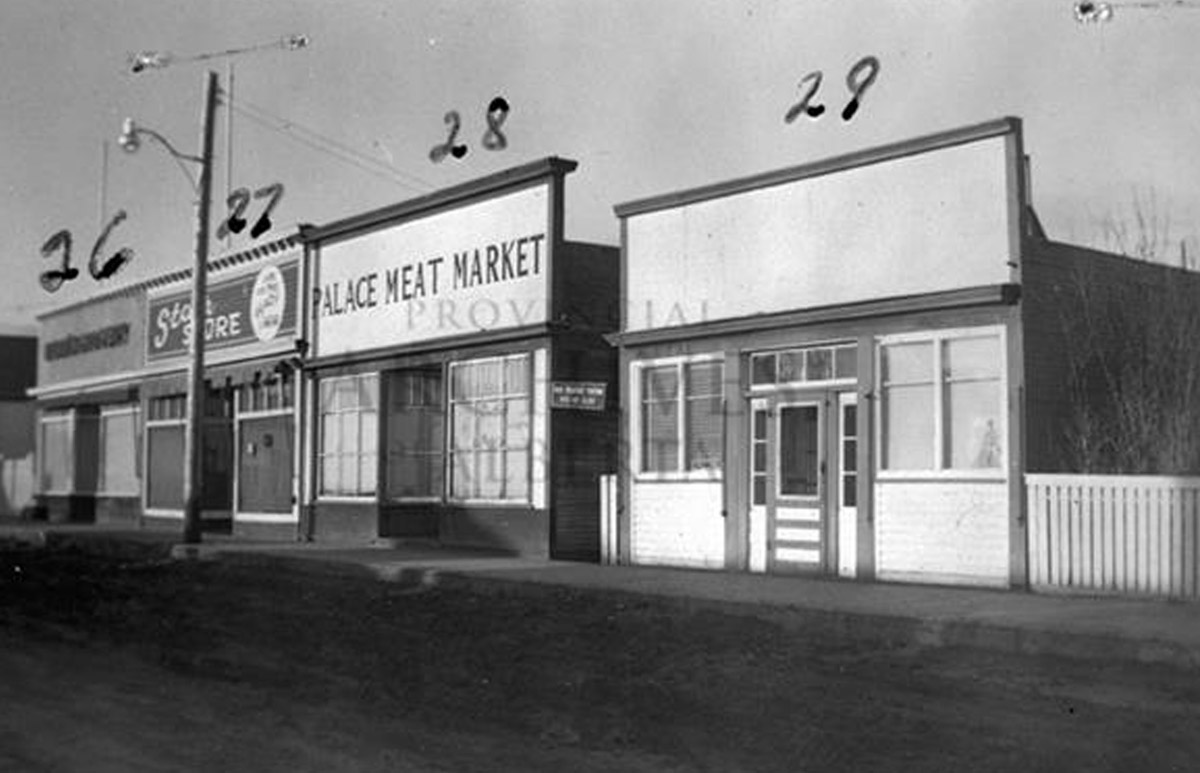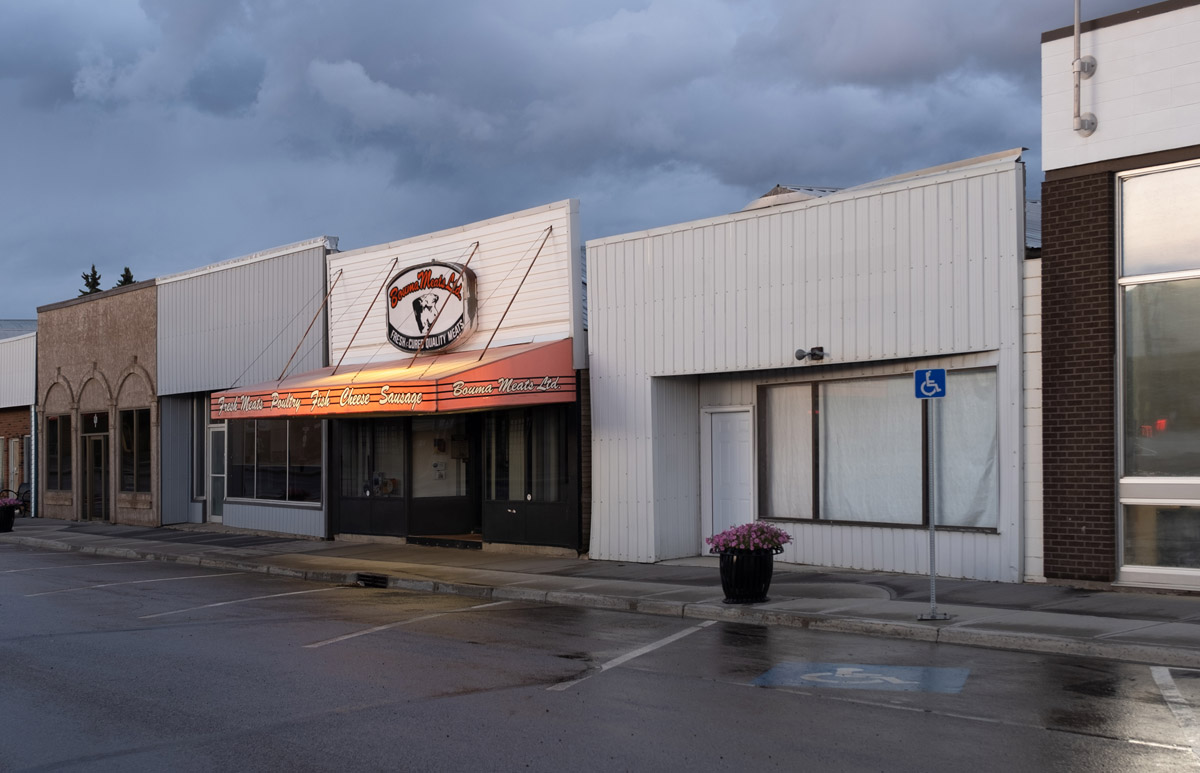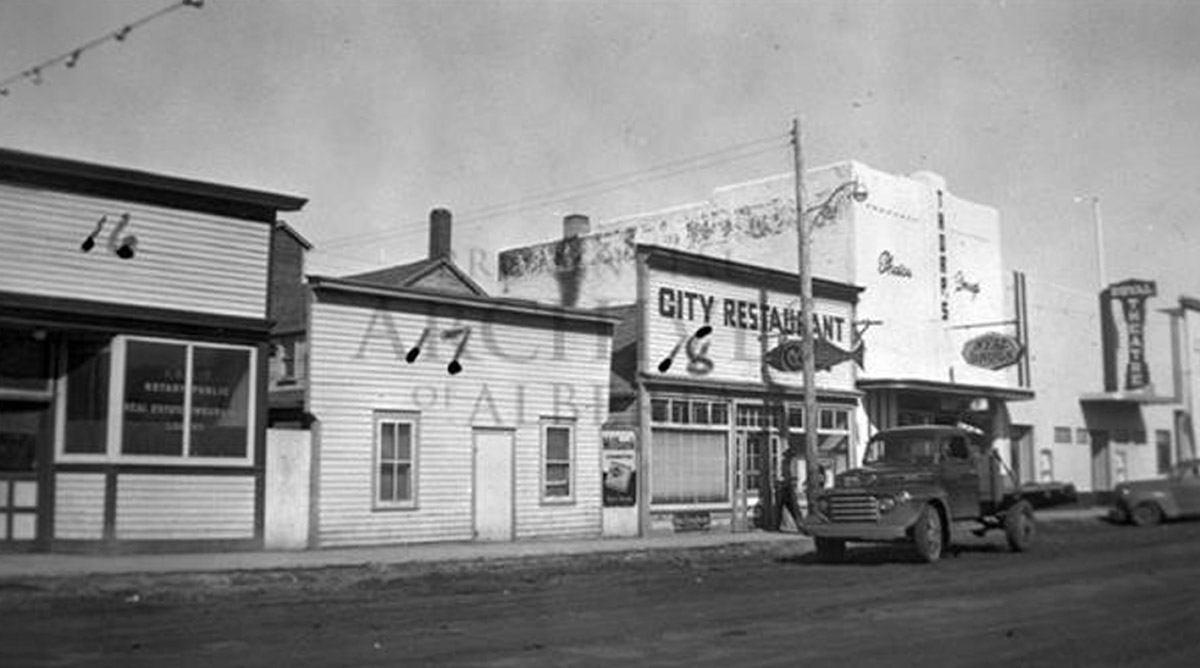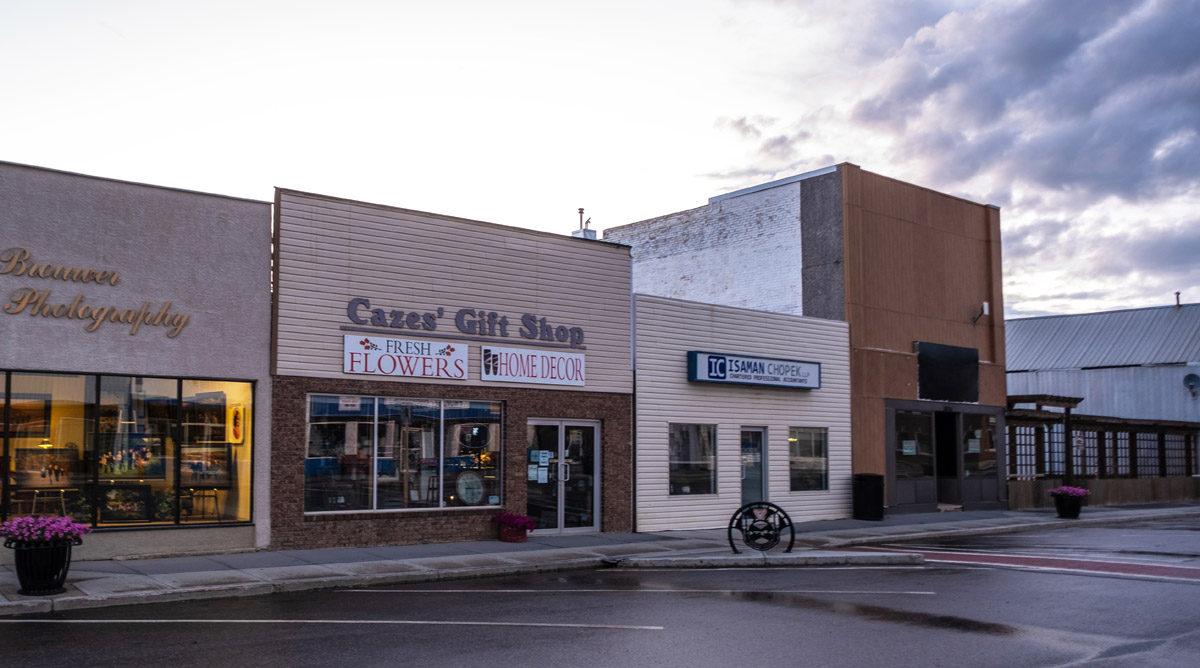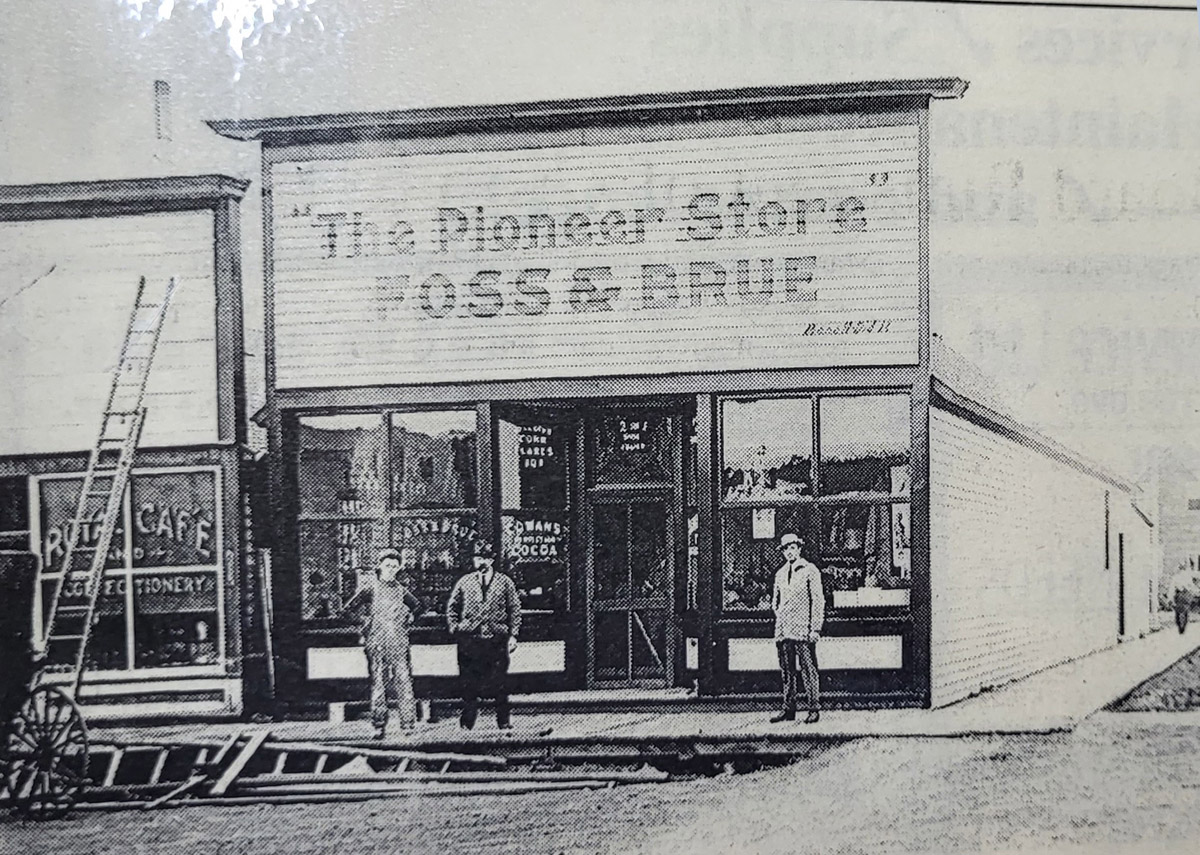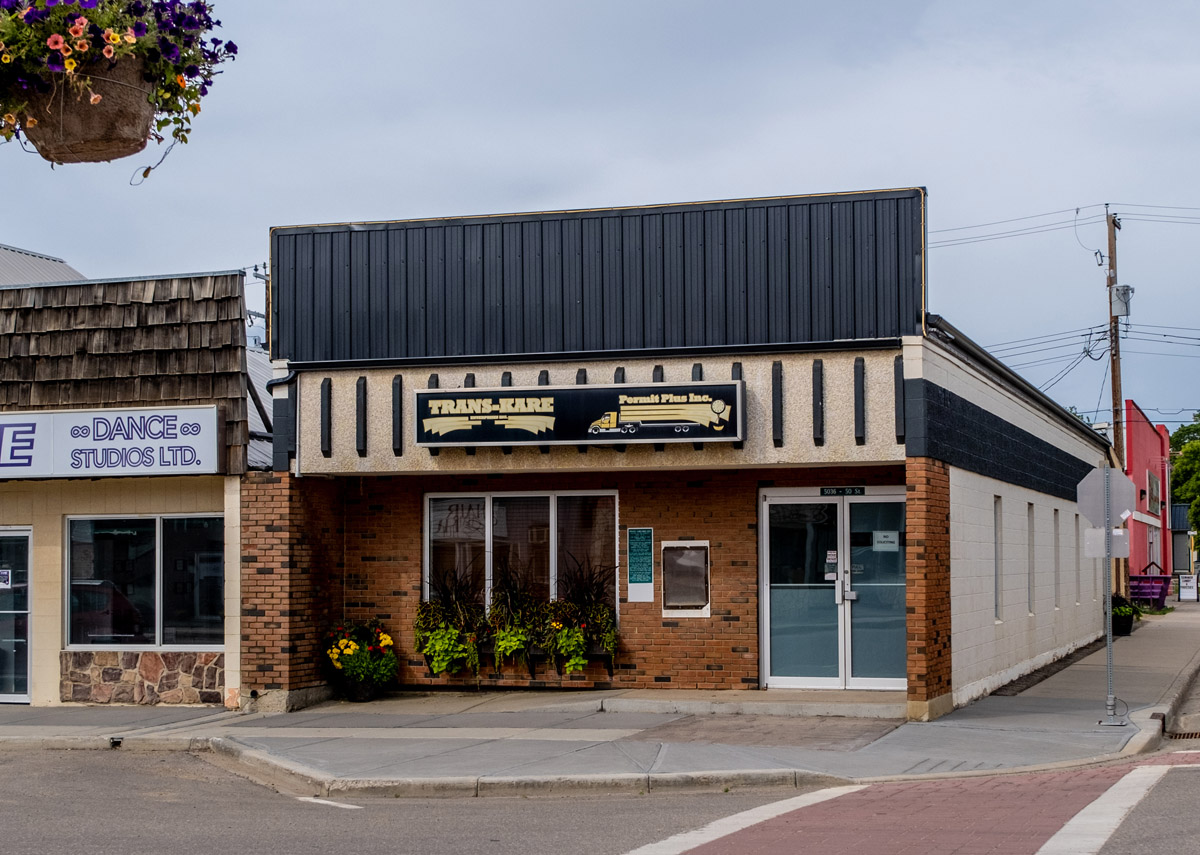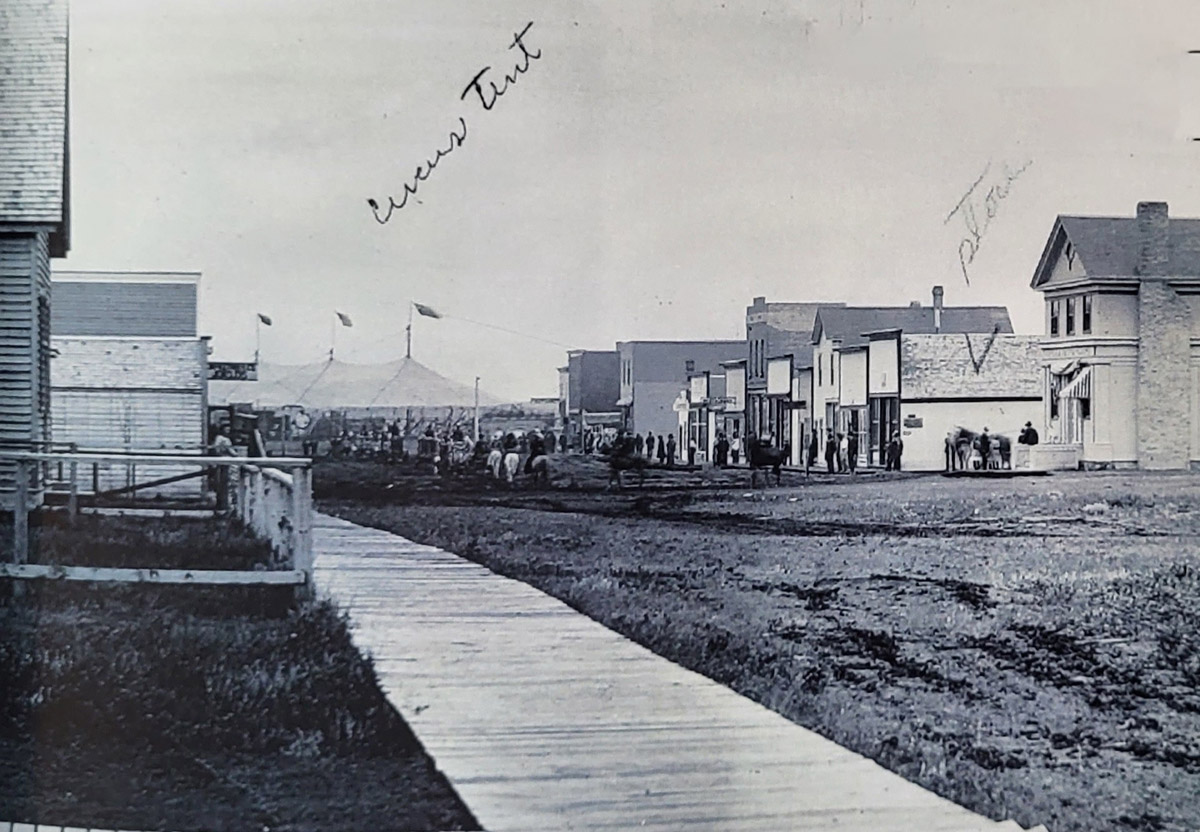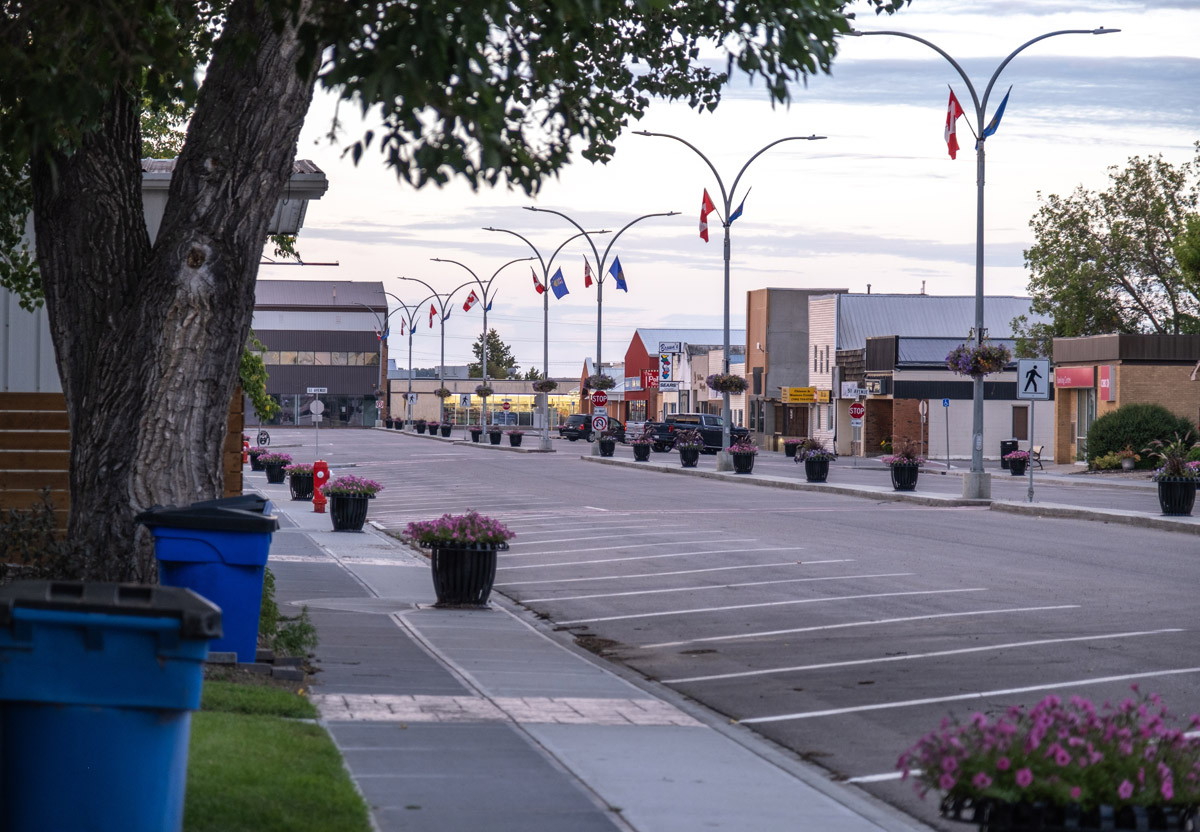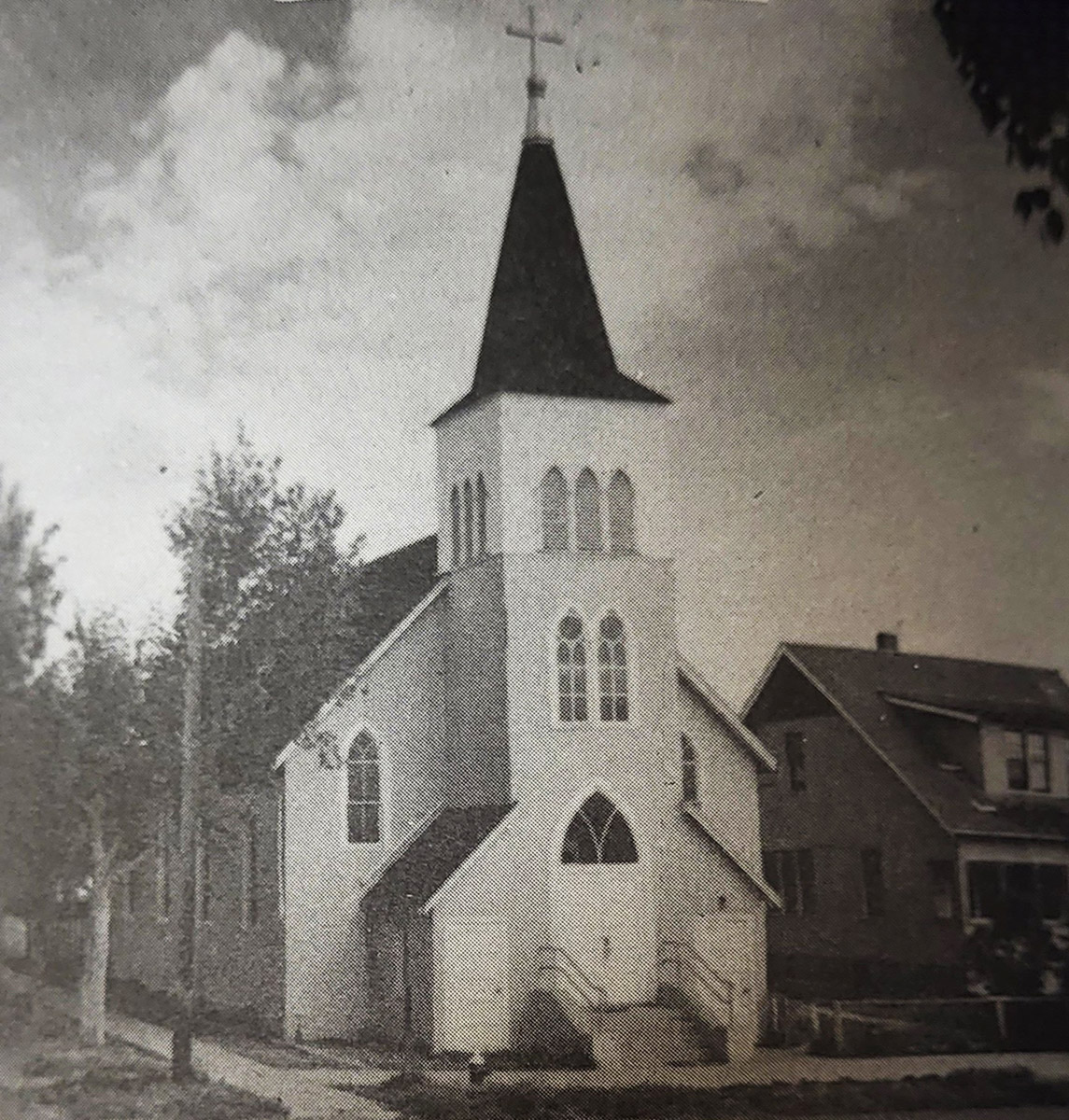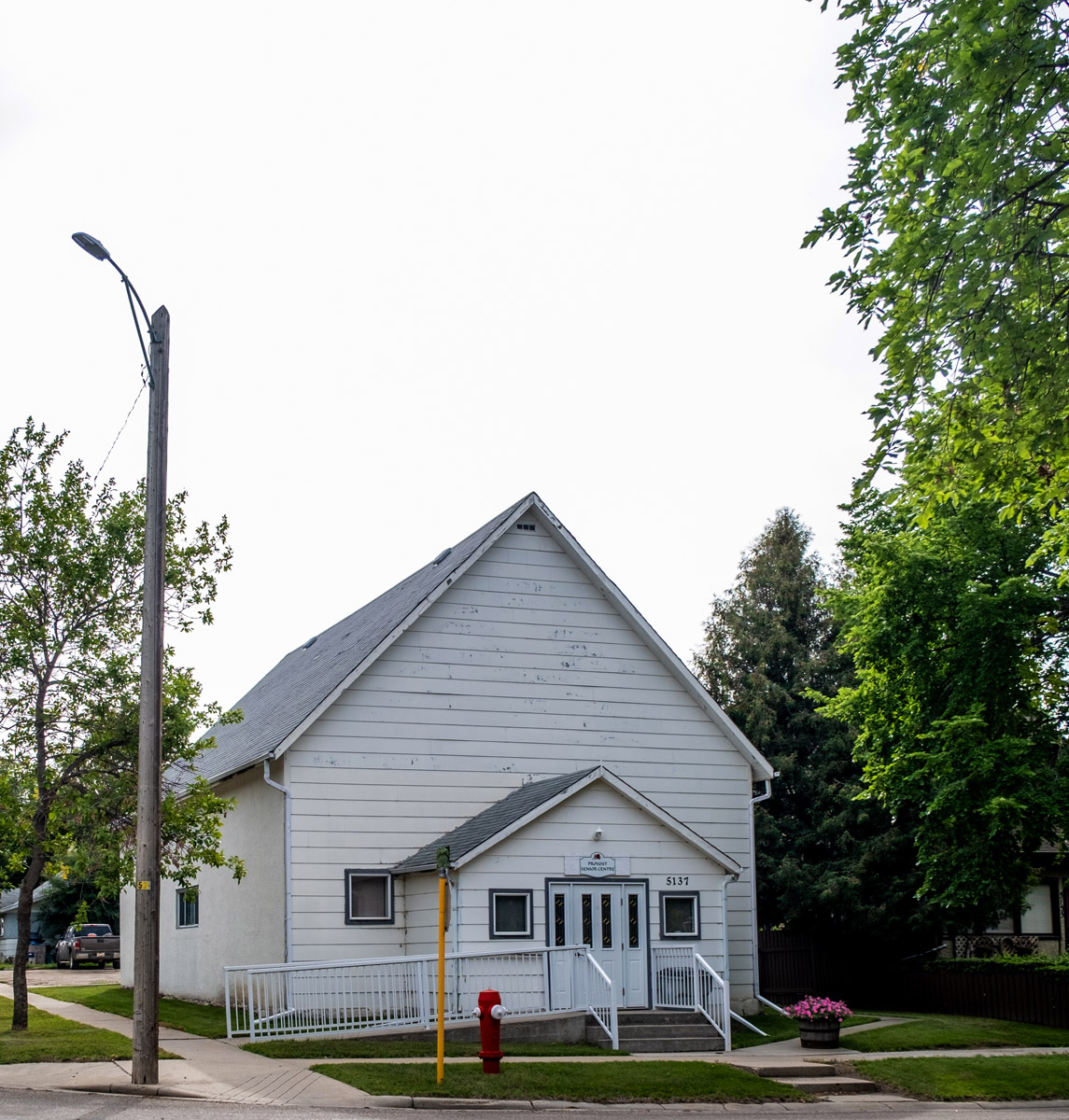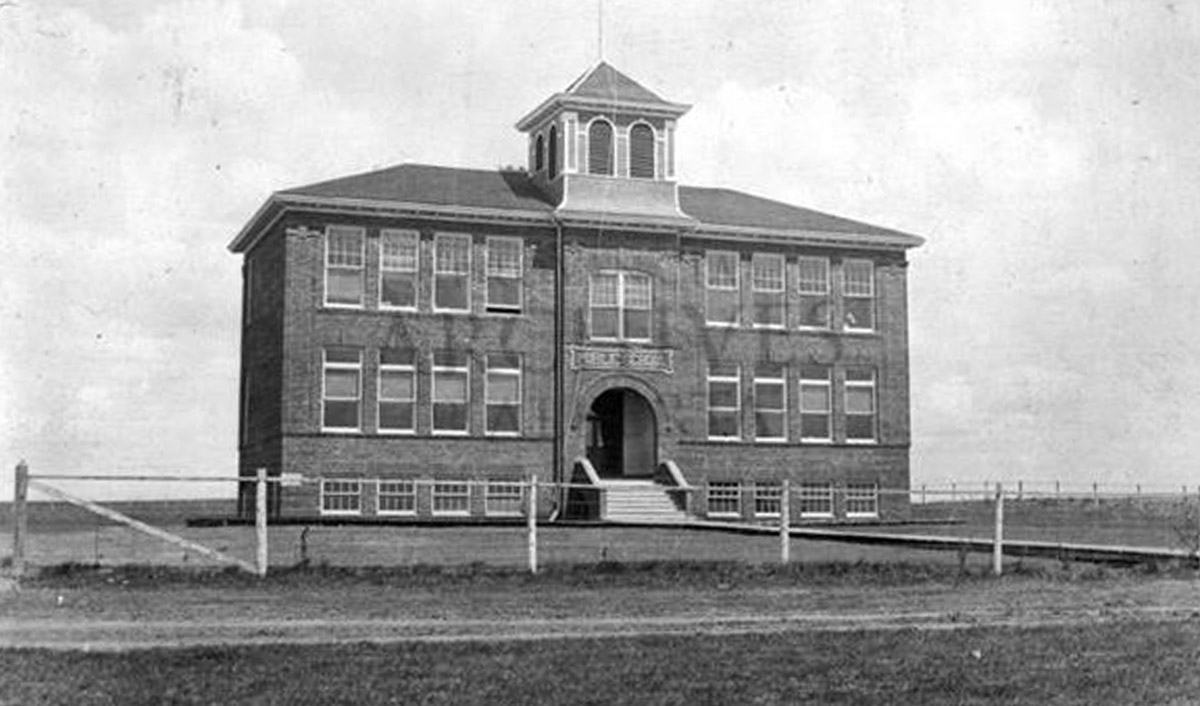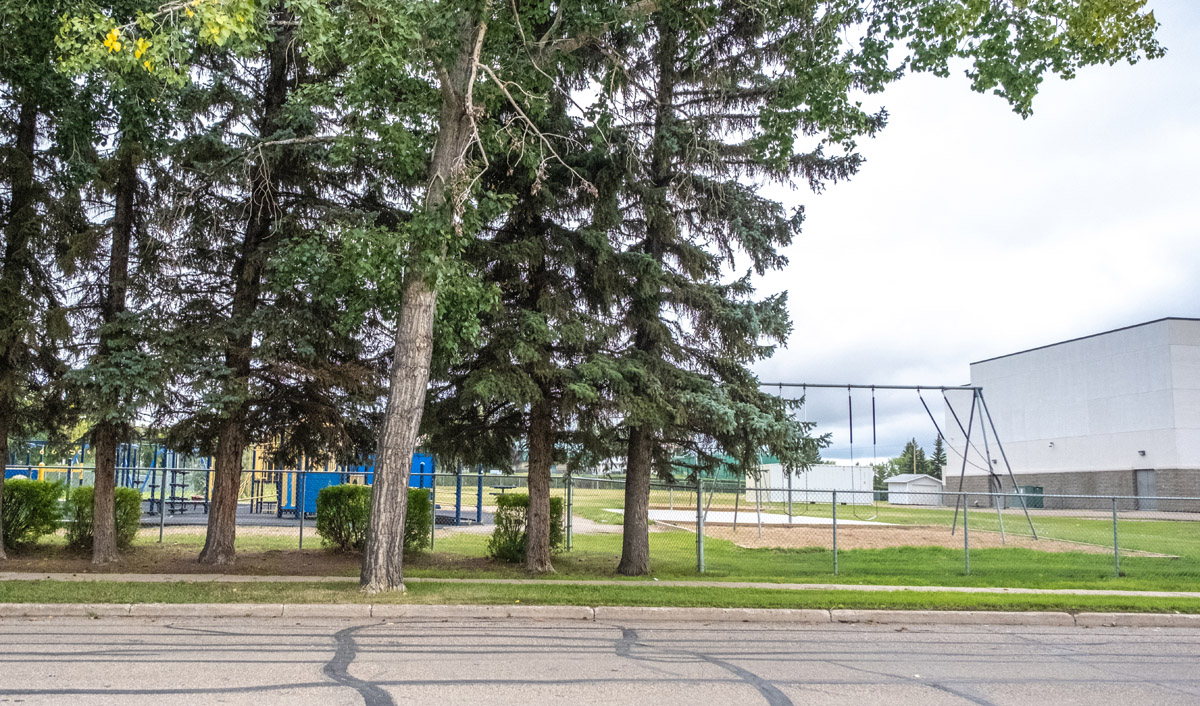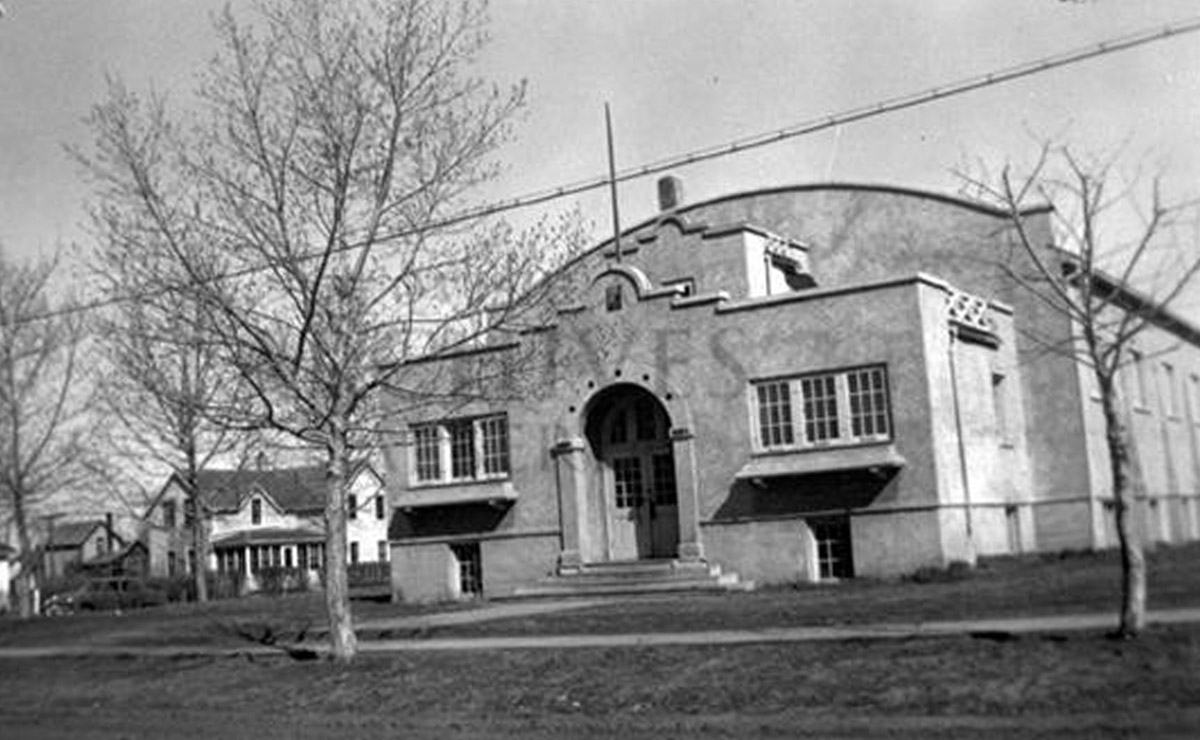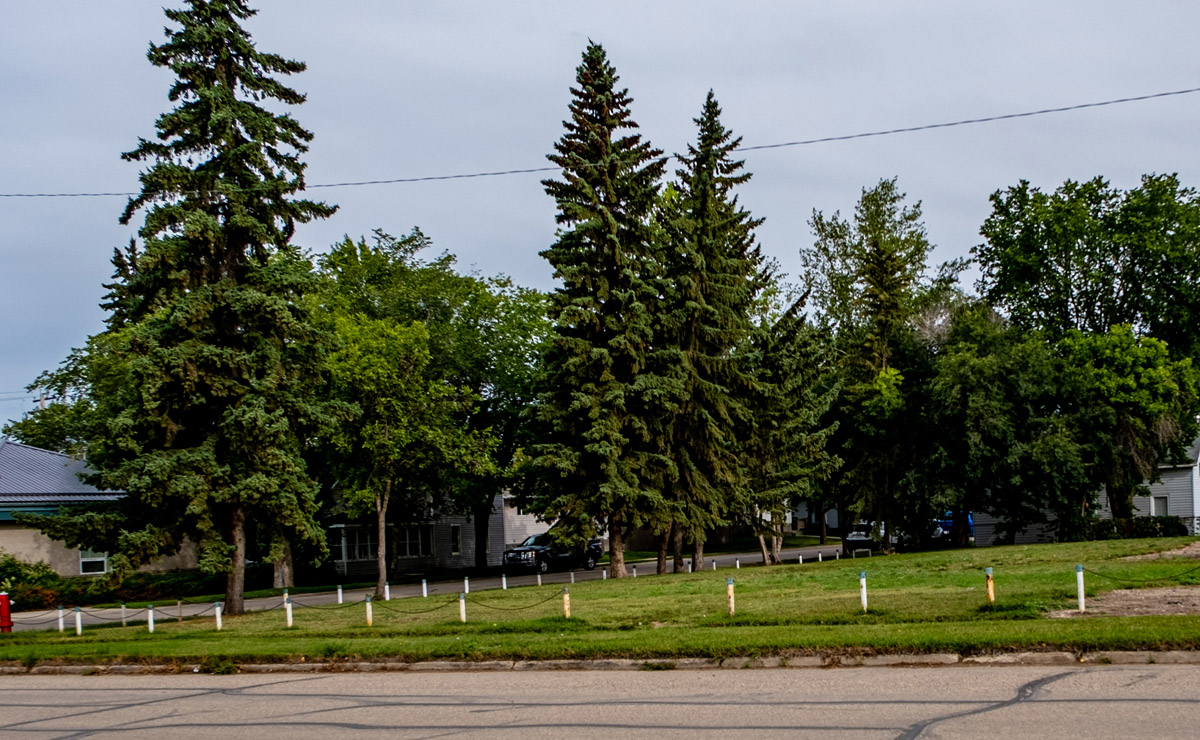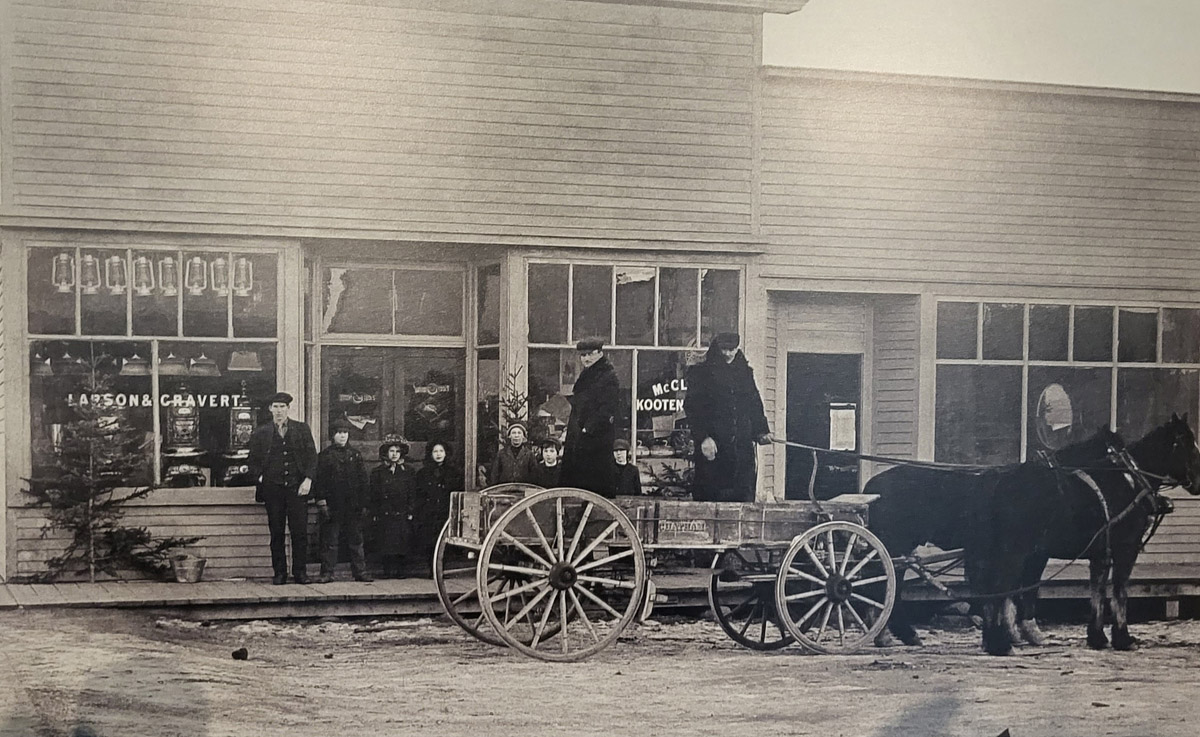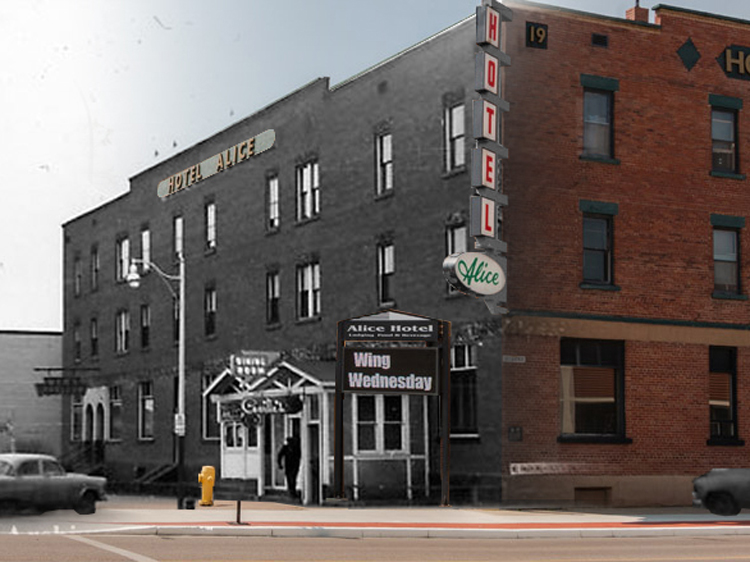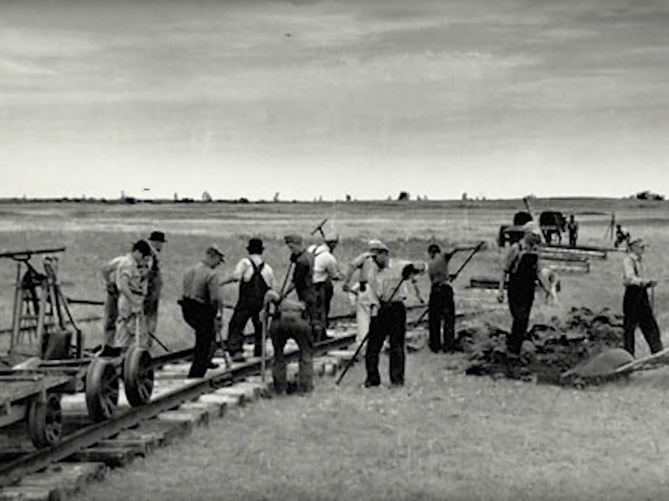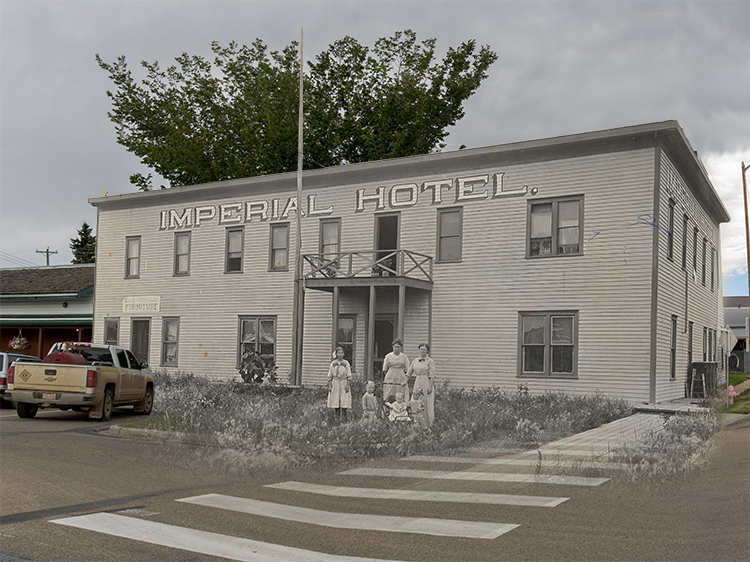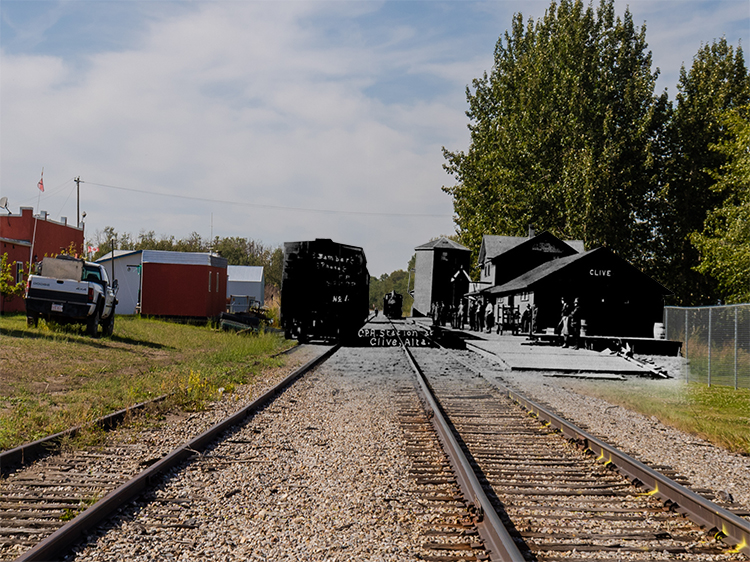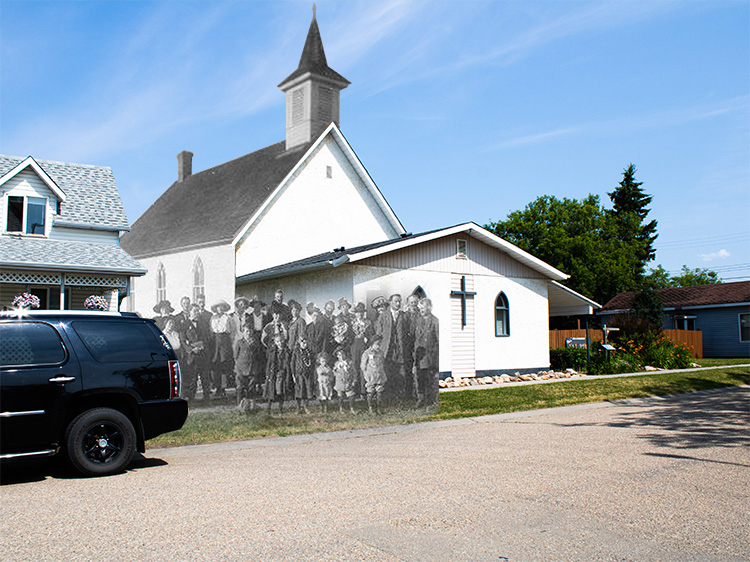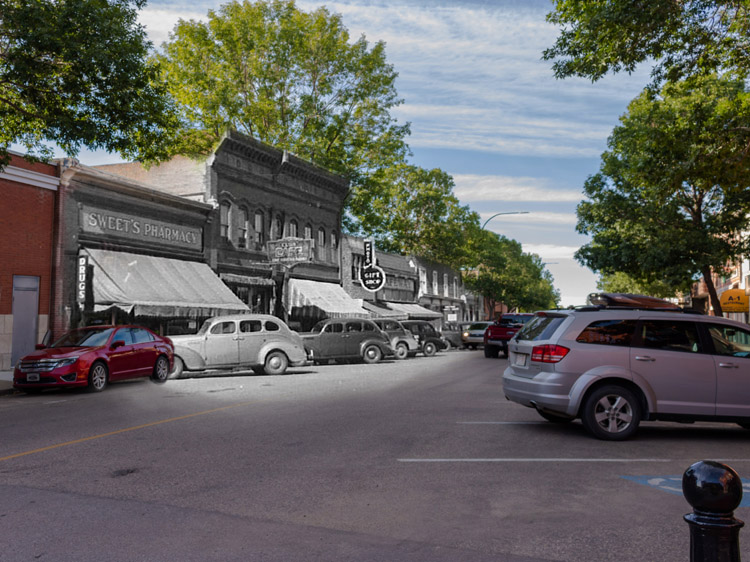Walking Tour
Provost's Pioneer Era
Origins of a Prairie Town
By Andrew Farris
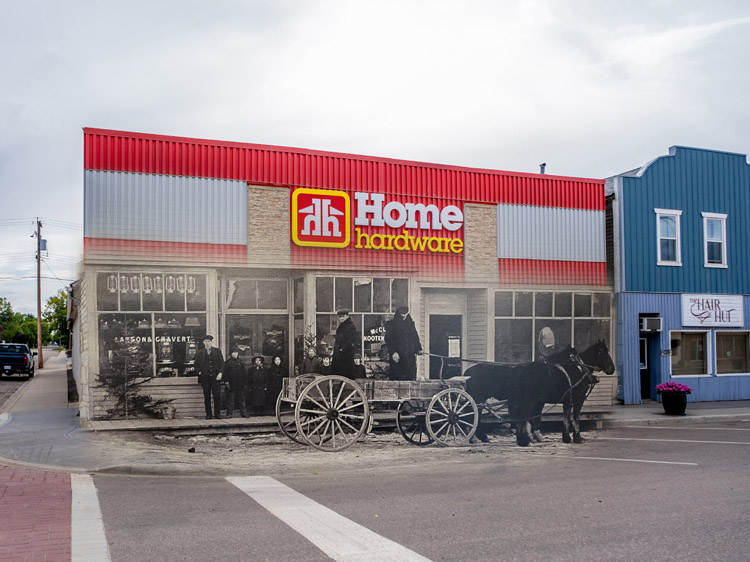
Take a journey through the exciting Provost's first decades, when a few bold settlers set out to build a town in the middle of an ocean of prairie grass. We start with the First Nations peoples who have lived on these prairies since time immemorial, and learn about Treaty 6 which set the stage for the full-scale European settlement of this region. Then we will see where the railway station once stood, and see how and why settlers began flocking to this town between 1907 and 1914.
We'll learn about the different groups of people who arrived here, like the Americans, Scandinavians, and Chinese, and how they contributed to the community. Then we'll walk up 50th Street (Provost's Main Street) and learn about businesses that shaped Provost, like the Pioneer Store, the Meat Market, and Club Cafe. We continue towards the west, discovering how people had fun in those days, and about the educational, religious, and volunteer institutions that shaped the people of Provost. Finally we'll return back to Main Street and conclude with Larson's Hardware, a family-owned business that has been in Provost ever since the beginning.
The tour is around 1.5 kilometres walking distance and will take around 90 minutes to fully complete.
This project is a partnership with the Town of Provost, with assistance provided by the Provost & District Museum.
1. The First Peoples
1954
The founding of the town of Provost is an exceptionally recent phenomenon, occurring just over a century ago. For uncounted millennia before Provost came to be, these lands were the home of the First Nations peoples of the Prairies, which included the Blackfoot, Cree, Dene, Sioux, Stoney Nakoda, and Métis.
These peoples thrived in this challenging and often inhospitable environment, living semi-nomadic lifestyles that carefully adapted to the rhythm of the seasons and followed the movement of the vast bison herds.
At the hamlet of Bodo, some 35 km south of Provost, you can find a remarkable ongoing archaeological excavation of a bison kill site. First Peoples from all round would travel great distances to gather there, and then use ingenious tactics to corral and slaughter migrating herds of bison, creating an inestimable windfall that would see them through the dark winter months to come.
The archaeologist Jack W. Brink writes "there is nothing in the four million years of human evolution where a comparable amount of food was procured at one time… Through millions of years of adaptation, mass killing of bison on the Great Plains of North America, using jumps and wooden corrals, was the most productive food-getting enterprise ever devised by human beings."1
Courtney Lakevold, archaeologist and manager of the Bodo Archaeological Society, has found evidence the Bodo Kill Site was in use for over 5,000 years.2
We cover this remarkable story in detail in our Audio Driving Tour, which will accompany you on a visit to the kill site, which is managed by the Bodo Archaeological Society and includes an interpretive centre.
* * *
Europeans settled on the Great Plains in what would become Canada and the United States in rapidly increasing numbers throughout the 19th century. They sought total control over the territory and saw the First Peoples as an impediment to these schemes. Unfortunately the First Peoples' dependence on the bison became a serious weakness in the face of European exploitation.
From the mid-1800s, the bison were hunted to the brink of extinction, first as part of the fur trade, and later with the deliberate aim of wiping them out and depriving the First Peoples of their ancient way of life. Starvation, along with devastating epidemics of European-introduced diseases, decimated the Indigenous societies, and made them reliant on the new settler governments for aid.
In a series of treaties in the 1870s, the First Peoples on the Canadian prairies were made to give up their semi-nomadic lifestyles and remain confined to reservations on marginal land under the watchful eye of Indian agents. Treaty 6 was signed in the summer of 1876 at Sounding Lake, just a short distance south of Provost.
The treaty was only written in English and included the clause:
The Plain and Wood Cree Tribes of Indians, and all other the Indians inhabiting the district hereinafter described and defined, do hereby cede, release, surrender and yield up to the Government of the Dominion of Canada, for Her Majesty the Queen and Her successors forever, all their rights, titles and privileges, whatsoever, to the lands included within the following limits…
As was often the case with treaties between the Crown and Canada's Indigenous peoples, the Cree representatives had a radically different concept of land ownership, and the ceding of it. Thanks to poor translation conducted orally on the spot, the Cree came away with the understanding that they were sharing the land, or it was just being borrowed.
In the treaty the government undertook to provide the First Peoples with regular provisions, equipment, and cash payments. Ultimately none of these guarantees would be honoured, and tens of thousands of Plains and Wood Cree and Blackfoot would die of starvation and epidemic disease on reserves in the 1870s and 1880s.
The treaty cleared the way for the settling of Provost some 30 years later.
2. Elevator Row
Provincial Archives of Alberta A4954
ca. 1916
Here we see the row of grain elevators that once dominated Provost's skyline. Boxcars sit idle on the railway tracks, and at left you can see the train station, with tall white lettering on its roof announcing 'PROVOST'. This scene would have been the first glimpse of the town that greeted many if not most of those who came here with the intention of beginningg a new life.
While today the elevators and station are long gone, rendered obsolete by the advance of technology and changing economics, in the historic photo they remain stark visual reminders of the twin imperatives that drove the founding of Provost over a century ago. The elevators held the grain that grew in the rich prairie soils of this region and underwrote the town's prosperity.
As the Provost Star wrote in its first edition on March 18, 1910, "The growth of Provost depends upon the growth of wheat."1 In those days, before highways and truck transport, the railway was the only reliable way to get grain to out to markets—and to bring settlers in.
* * *
In the 1850s politicians in Toronto and Montreal were beginning to dream of uniting all the colonies of British North America into a Canadian Dominion that stretched across the continent from Victoria to Halifax.
They saw that Americans were beginning to settle and farm the plains to the south, and they feared if they didn't do the same then American settlers would simply move in and occupy the prairies north of the 49th Parallel. They decided to take another look at the farming potential on the prairies and sent an expedition headed by John Palliser to survey the region.
Palliser's findings prompted great enthusiasm. He identified a vast area, known as Palliser's Triangle, as semi-desert but suitable enough for cattle ranching. Ringing it however he found belts of extremely fertile soil that could support the kind of sustained settlement needed to bring these areas under Canadian control.
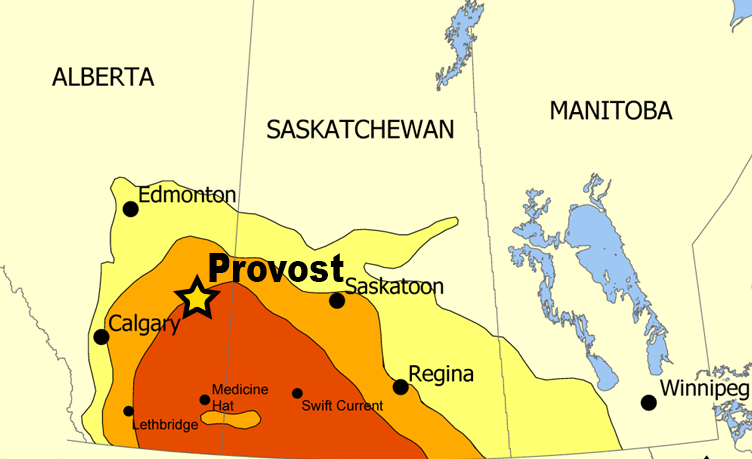
The Canadian Pacific Railway came east through Alberta in 1885, crossing to the south of what would become Provost through the middle of Palliser's Triangle. Most of the land in the region was given over to cattle ranching and immigration remained relatively low.
However, by the early 1900s, it was discovered that the Triangle was arable after all—if great matrixes of irrigation channels could be built. Furthermore a new strand of wheat, called Marquis, could withstand the challenging climate and periodic drought conditions. Suddenly the agricultural potential of the region was looking a lot more promising.
This coincided with a massive push by the Canadian government to import millions of immigrants to the prairies. Homesteaders and investment flowed in. The decade before the First World War saw the greatest immigration boom in Canadian history, with over a million immigrants settling across the prairies. The economic potential of the region fanned a railway mania that saw the building of two more trans-continental rail lines and hundreds of spur lines.
In 1907, along one of these spur lines, near the top of Palliser's Triangle, the Canadian Pacific Railway engineer David Livingstone surveyed the townsite that would become Provost.2
3. The Settlers
University of Alberta PC029133
ca. 1920s
The railway station that once greeted arrivals to Provost. After the Canadian Pacific Railway decided to plant a settlement here in 1907 and surveyed the townsite, people began to arrive immediately. Some enterprising entrepreneurs, like P.O. Foss and J. Brue, arrived even before the train tracks. They took a bumpy wagon ride from Hardisty and set up a store in a tent to serve the people they knew would be flowing in.
Who were the people that settled here? Most were young men eager for the 160 acres of free land promised to those who homesteaded for three years. Some enterprising entrepreneurs, like Foss and Brue, had dreams of setting up stores and selling provisions to the would-be farmers. Like many, they brought their young wives from Minnesota once they had become established.
There were many potential roles to fill in a new town that had just been dropped on the prairie. The town would need hoteliers, restaurateurs, shopkeepers, realtors, ministers, journalists, bankers, doctors, and pharmacists, to name a few.
* * *
As Americans from the Midwest, the aforementioned entrepreneurs Foss and Brue were not without company. The town's first doctor, W.O. York, had come from Arkansas. The Alberta prairies were just opening up to homesteaders after the American Frontier had been declared closed in 1897, and no more free land was to be had.
The frontier moved north of the border. The Canadian government thought Americans to be desirable immigrants who "brought machinery, money, and farming experience," and ran huge advertising campaigns to bring them here. They were wildly successful: Between 1898 and 1914 some 60,000 Americans (mostly farmers) emigrated to Canada. In 1911 they amounted to almost a quarter of Alberta's population.2
Many of these American transplants had originated in Norway and Germany. The region around Provost drew many Catholics from southern Germany, who named the hamlet of Rosenheim just to the south after a town in Bavaria. For those immigrants to America who had arrived too late to the free land party, places like Provost provided fresh opportunity.
A Swiss-German named Carl Stettler came to Alberta in 1903, and he wrote back to his compatriots in the Midwest encouraging them to join him in the Great White North:
"Conditions here are more orderly than in many places I have seen in the United States. Your life here is safer than there, nobody carries firearms with the exception of the police…laws are obeyed better…altogether the people are more decent and better mannered…who has courage, good will, enthusiasm for work and push will advance quicker here than anywhere else, as this country is only in a state of development and excellent chances are offered."3
Canada's welcome to immigrants was extremely selective however. Prevailing attitudes towards non-Europeans would appear to us as outrageously racist. These non-Europeans were strongly discouraged from immigrating—and sometimes legally barred from doing so.
As for the acceptable immigrants from Western, Central, and Northern Europe, (Eastern and Southern Europeans, such as Italians or Ukrainians were only grudgingly tolerated) they were expected to be loyal and adopt the British-dominated and -inspired Canadian identity.
As Wilfrid Laurier said in 1905 while proclaiming the founding of the province of Alberta:
"We do not want nor wish that any individual should forget the land of his origin. Let them look to the past, but let them still more look to the future… Let them become Canadians, British subjects and give their heart, their soul, their energy and all their power to Canada, to its institutions, and to its King."4
4. Pioneering in Provost
ca. 1910s
Here we see a farm team at the main intersection in downtown Provost with their new tractor and its trailers for aerating and furrowing the prairie soil. Behind them we can see the new hotel, which doubtlessly some of these men would be staying in as they assisted with seasonal farm labour.
Settlement of Provost began in the summer of 1907 with the surveying of the townsite, but the tracks themselves would not arrive until December 1909. Nevertheless in that interlude the town still drew in some optimistic and hardy pioneers.
When S. Dunbar arrived in early 1909 to become an assistant at the Canadian Bank of Commerce he found three general stores, a hardware store, "and very little else."
Writing some 15 years later, he fondly remembered his experiences at the founding of the town:
"Looking back at them now, our pioneering experiences seem to have been not uninteresting, and as I had been in the country about two years at that time, and was a real tenderfoot, the memory of them is still very vivid to me."1
* * *
Without the railway, their contact with the outside world was still minimal, confined to periodic supply wagons from Hardisty. The Saturday mail wagon was "the big event of the week."
Unusually, his job as bank assistant didn't seem to imply an inordinate amount of work. The bank's safe was broken, so he carried all the depositors' cash around in his pocket while Gordon would carry a gun as protection.
"We were by no means overworked… We settled many knotty political and world problems sitting around on lbags of flour in the various stores. It was a lonesome country, the real prairie, and we could stand on the railroad grade and see miles and miles of snow in every direction."
The town continued to grow through 1909, and when the railway arrived at the end of the year, the tempo of life accelerated. At that point Dunbar thought "Provost was away to a good start."2
Several months later, in March, the Provost Star published its first edition and reflected on those first years of Provost's development:
"We have been struggling for some few years against the hardships incident to a pioneer life. But the struggle has given us strength, and in light of present achievement we look forward with cheery hope to the future. The years that are to come will not be idle years, but are we not firm believers in the doctrine of work?"3
5. Planning a Town
ca. 1910
A view down the West side of 50th Street showing the Coffey real estate office on the corner around 1910. As Pierre Berton writes, in those days "To be a realtor one needed no more than a hole-in-the-wall office, a counter, a table and a few chairs, a typewriter, and some correspondence paper."1 It was a good time to be in the real estate business.
The arrival of the railway at the end of 1909 was welcomed by the community's inhabitants, who incorporated Provost village the following January. The upgrade to town status came in the 1950s.
* * *
This was all occurring in the backdrop of a land frenzy that swept the West in the decade preceding the First World War. Everyone was obsessed with buying and reselling real estate. For instance, "In 1908, Saskatoon had eight real estate brokers; by 1912 it had 257," writes Pierre Berton. In Calgary some 2,000 men were employed as realtors, fully 10% of the adult male population.1
Provost was not immune to this mania, and as soon as the lots were laid out people began to snap them up. Realtors like Coffey's became a booming business.
When Eleanor Carter arrived in early 1910, she recalled that there were then four general stores (Briggin-shaw's, Simpson's, Tiffin's, and Foss & Brue's), a post office (inside Foss & Brue's), Joe Eaton's meat market, two hardware stores (Larson's and McNeil's), two lumber dealers (Johnstone's Lumber and Beaver Lumber), a blacksmith (Bob Dick's), a real estate office (Coffey's) and two churches.
"Provost was booming," she recalled.3
6. Cattle Ranching
Provincial Archives of Alberta A13275
1951
Bouma Meats has been serving Provost for decades, but before that this building was occupied by the Palace Meat Market. It is hardly surprising that a butcher was one of the first businesses to open in Provost in 1910, as cattle ranching has been an integral part of the culture of this region since the 1870s.
* * *
However, when developments in agriculture opened up the region for intensive farming, homesteaders took up their plots of land and fenced them in, leaving less and less room for the ranchers, who complained bitterly. The decline in cattle ranching was helped along mightily by a series of terrible winters from 1905 to 1911, which in some cases wiped out up to 80% of the herds.1
Nevertheless cattle ranching never went away. Instead it took on new forms. Homesteaders on more marginal land, like the Frasers, Phipps, and Miekles, started raising their own small herds. Some so-called 'cattle kings reconsolidated huge plots of land for ranching in southern Alberta, allowing the industry to stage a comeback. It remains an important part of Alberta's economy today.
7. The Chinese Community
Provincial Archives of Alberta A13268
1951
The City Restaurant on the west side of 50th Street, one of Provost's Chinese-owned businesses. It was founded by Lee Lung, an early pioneer who made Provost his home in 1909. The Club Cafe, as well as a laundry, were also owned by Chinese pioneers, while Chinese men worked as cooks at the Provost Hotel.
In 1977 the Chinese contribution to Provost was described in the book Early Furrows:
"The Chinese were never very numerous in Provost but they were certainly very active, very visible, and a very important part of the town. As a matter of fact it seems not unlikely that their presence in Provost was one of the reasons why Provost grew even when times got tough as they did during the years of depression and drought."1
Early Furrows does allude to the painful prejudice these Chinese pioneers experienced at the hands of their white neighbours. Furthermore, due to racist and discriminatory immigration policies, extremely few Chinese women were able to immigrate to Canada, leaving their menfolk in Provost very lonely and isolated.
8. The Pioneer Store
ca. 1910s
This is the Foss & Brue Pioneer Store, the first to open in Provost. We can see here it is a substantial wooden building, which superseded a more modest one built in 1908, which itself superseded an even more modest tent on this same spot. The town's post office was run out of this store, with P.O. Foss as postmaster. Jacob Brue himself set up his own homestead three kilometres north of Provost.
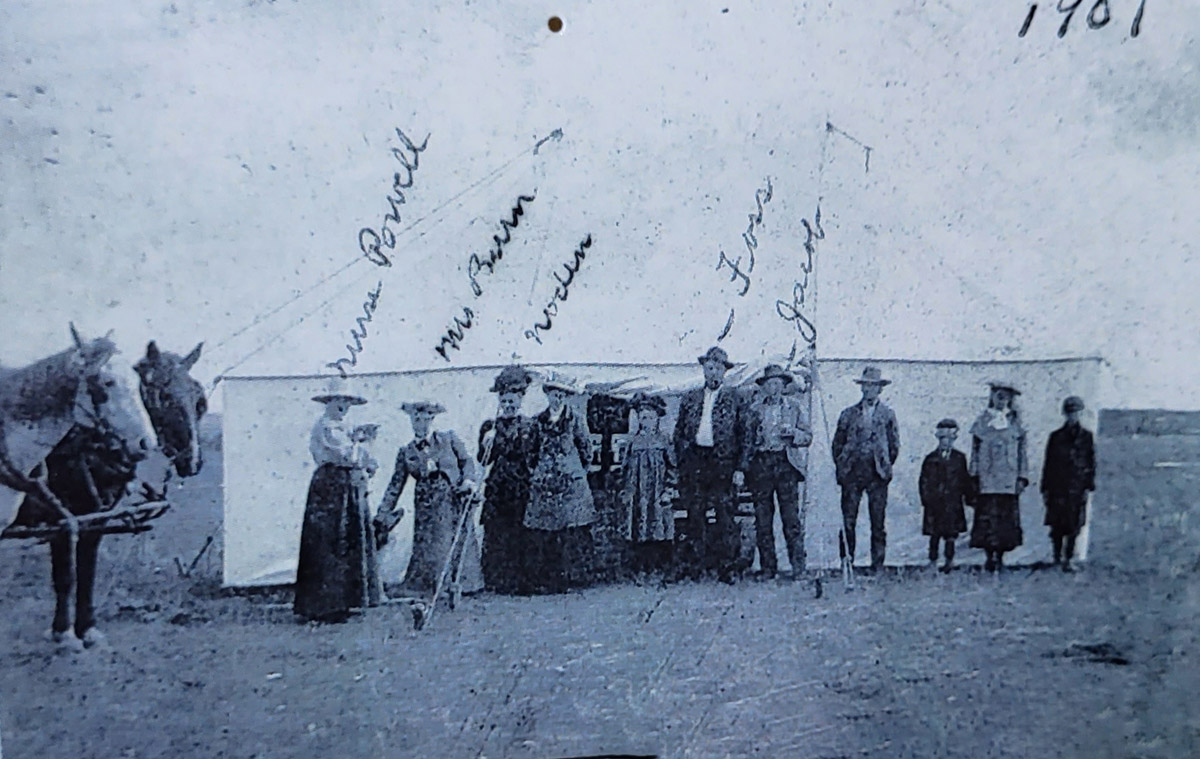
Jacob had a bad bout of typhoid in 1908, but was saved by the attentive care of Dr. York, who made the gruelling journey from Hardisty to check up on him, as well as by the efforts of Olaf Osmundsen, who "took on the role of night nurse… during the most critical nights."
In addition to the arrival of the railway, a "much appreciated improvement," for the two men was the building of the hotel, "as they were getting tired of their own cooking."
* * *
Jacob's wife, Martha Brue, wrote about those early pioneering days in the Early Furrows history book. She recalled the cold winters and how Jacob would have to commute to work from their homestead on skis.
The Foss & Brue Pioneeer Store became the centre of the town, a hub of activity, and—as post office—the place for people to gather, gossip, and hear the news from the outside world.
"When farmers came in to shop or to pass a little time on those cold days, there were many weighty and important problems discussed and solved around that big pot-bellied stove in the back of the Pioneer Store."
"We spent many happy years in Provost, had our children there and their first years of public and Sunday school." In 1920 however their great friends, the Foss's left for Vancouver, and Jacob and Martha "began to have visions of flowers, green grass, and warmer climate." A year later they also made the move to the west coast.
Martha always fondly remembered her "home town" and was still subscribing to the Provost Star 50 years later. 1
9. Having Fun
ca. 1910s
In this rather curious photo taken from this spot looking south towards the end of 50th Street, we can see that a huge circus tent has been erected. Evidently a travelling circus had come to town, what was sure to have been a memorable event.
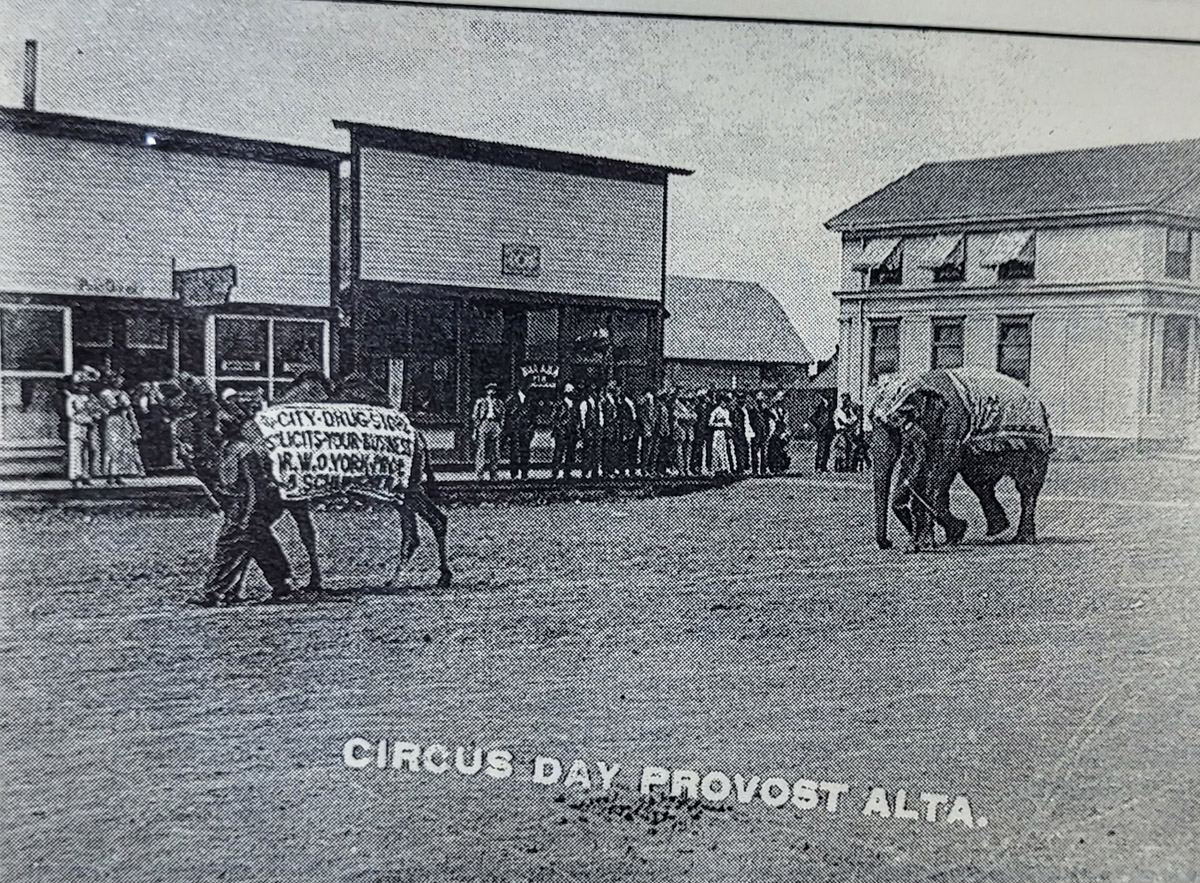
* * *
Sports was an everpresent diversion, with baseball and basketball proving the most popular in the summer, while in winter everyone took to the rinks to play hockey or curl. "Nearly all our people were quite sports minded," writes J. Dobson.1
The harness shops and livery stables meant there were lots of horses around, ostensibly for farming, but many had the opportunity to ride out over the open prairie. Before the decade was out the town boasted a (very popular) pool hall, a bowling alley, and a movie theatre.
Edna Larson recalled the litany of activities that occupied her childhood:
"There are so many happy memories of those days—too numerous to mention. There was the Lutheran Ladies Aid, held out south at Knudsens, or some place—the May 17 celebrations at Kikennes.
"We went to the Big Gap Stampede, that great distance in the old ford. There were Whist Drives and Box Socials, but I was too young. I do remember the New Year's Eve Fireman's Ball. It was held over McNeill's Hardware Store… Old and young went. There were no baby sitters.
"Picnics at Moore's Lake, CGIT camp, where we always went on the local to Czar and Hardisty Lakes. We had to pitch our tents and get our ticks filled with straws. What fun we had!"2
10. Churchgoing
ca. 1920s
The Provost Senior's Centre was once St. Mary's Catholic Church, though its steeple and stained-glass windows have been removed. The church was built in 1910 thanks to contributions from Provost's small Catholic community. The congregation outgrew this small church in the 1960s, and in 1969 they moved to a larger and more modern building a couple blocks to the east on 45th Street, where they continue to worship today.
Provost's early pioneers relied heavily on their faith, and each group of immigrants wasted no time in organizing religious services and then raising funds to erect a house of worship for their own respective denomination. In a spasm of community-led construction, between 1908 and 1910 churches were built for Catholics, Anglicans, Lutherans, Methodists, and Presbyterians. The Baptists rented space from the Methodists for their services.1
* * *
The representation of six different christian congregations in this small town also tells us much about the diverse origins of these settlers. We should say diverse for the time, as they were all christians who ultimately originated from different parts of Europe (many coming via the American Midwest or Central Canada).
The Catholics of Provost primarily came from the Catholic-speaking regions of southern Germany, and had an enormous impact on the region's development. The community of Rosenheim, located just south of Provost and home to the impressive Gothic Revival style St. Norbert's Church, is named for a town in Bavaria.
St. Norbert's itself is an important heritage and featured heavily in our accompanying audio driving tour. Today there are 580 self-identified Catholics in Provost, nearly a third of the total population and by far the largest single religious group.
The Anglicans primarily came from England, and they held their first service in 1908 in the attic of Larson's Hardware store. By 1909 they had begun work on St. Paul's Church, and it is noted that throughout the following decades attendance averaged 20 people, with a high of 70 and a low of 4. Today there are only a few dozen practicing Anglicans still in Provost.
Methodists were committed to a social gospel of education and help for the poor and was especially popular in Ontario. Presbyterianism was another denomination committed to these same values, though it originated in 16th century Scotland, and most of its adherents were Scots. The two churches found their beliefs compatible enough to amalgamate in 1925, creating the United Church of Canada. They account for just under 10% of Provost's population today.3
Lutheranism was the dominant religion of Scandinavia and northern Germany, as is evident from the surnames of those attending the first Lutheran service in Provost: Hansel, Asmavik, Lakevold, Flexhaug, Foss, Knudson. Most of these families had emigrated from Norway to the American Midwest. From there they were drawn to Alberta by glittering advertisements for free land on the Canadian frontier.
The small contingent of Baptists seem to have mostly been immigrants from the United States. Evangelist denominations like the Baptists that were popular south of the border came to influence Alberta's cultural development in the decades that have followed.
11. Education
Provincial Archives of Alberta A4953
ca. 1916
We are looking across the street to today's Provost Public School. We can see in this historic photo from the 1910s the red brick schoolhouse that no longer stands, though one of the cornerstones in the foundation was recently uncovered in the playground to the left of the modern building.
Schooling and education were extremely important to the early settlers, and the community made great investments in ensuring their children got the best possible start in life. The story of Provost's educational development is one of progress and expansion.
* * *
This state of affairs could not be maintained for long, and a year later the first school was built on this plot of land before you, which had been set aside for the purpose by the Canadian Pacific Railway surveyors. It was a small wooden one-room schoolhouse.
It wasn't long before a bigger one was needed, as more immigrants arrived and they started having children—the first child was born to a Provost resident on June 1, 1909, and named Alberta Christian.1 In 1915 the four-room brick schoolhouse you see here was built. By 1922 further additions had to be built.
In those days most children only received an elementary school education, and would often spend their teenage years helping out on the farm. This started to change in earnest after the Second World War, when thriving in post-war society began to require more specialized knowledge. In response to this increasing demand for secondary education, a high school was built in 1949.
Nevertheless, in the 1950s and 60s overcrowding became an increasingly serious concern, as the baby boom brought far more children than ever before into the schools. Furthermore children on remote homesteads, who previously could only access education through home schooling, could now be bussed into Provost. An elementary school was built in 1960, and later on the much larger and more modern public school you see before you was finally completed.2
12. Community Spirit
Provincial Archives of Alberta A8943
ca. 1951
This photo shows the Elks Hall that once stood on this lot, one of a number of voluntary community organizations that flourished in Provost over the 20th century. These were extremely popular, and most of the town's residents were part of one or a number of these groups. They helped to create bonds between who lacked common origins and histories, and eased the integration of new arrivals into the community. The Elks of Canada were founded in 1912 and became the country's largest all-Canadian fraternal organization. While the hall served as a social hub and gathering place, their efforts were mainly aimed at charity drives and community volunteering. A similar fraternal order present in Provost were the Freemasons (Provost #61 Masonic Lodge), while veterans joined the Royal Canadian Legion (Provost Branch No. 85). Women also had voluntary organizations to join, like the Provost Ladies' Royal Canadian Legion Auxiliary (founded in 1951). Churches too were central organizing hubs for community engagement, and each congregation had its own set of social functions, charity funds, and volunteer drives.
* * *
Some historians have tried to analyze this facet of Alberta's culture:
"As Paul Voisey has noted in his study of the Vulcan area,” despite differences between farmers and ranchers and differences in wealth, ethnicity and religion, open conflict seldom disturbed smalltown and rural life. Since the population base was small and institutions fragile, conflict could not be allowed to disrupt voluntary organizations, local politics, or commerce. Farmers and townspeople united instead against common enemies - banks, elevator companies, the CPR, eastern politicians and rival towns. The price of unity was often intolerance of difference and dissent."1
The forces that shaped Provost were by and large represented across Alberta, and lent to the forging of a new and unique culture:
"By design, the educational, religious, and political institutions of the new society were based largely on a Central Canadian model. However, out of the interaction of diverse people's whose traditions were circumscribed by climate, geography, and the constraints of Canadas economic and political system, a new society gradually emerged on the prairies, and in Alberta, different from those in other regions of Canada."2
13. Larson's Hardware
We've returned to 50th Street where our tour concludes in front of Larson's Hardware, the longest continually operated business in Provost. Through all that time and over five generations the store has continued to be run by the descendants of Fred Larson. It is an unbroken legacy that has left an indelible mark on this prairie town.
Fred Larson, a Danish immigrant who had settled in South Dakota where he met his wife Carrie, made the move to Provost in 1908.
This picture shows the hardware store in the early 1910s, with two men (one of them Fred) standing in the back of a horse-drawn cart in heavy winter coats. In front of the store the young man standing to the left is Fred's son Elmer, and to his right are his little sisters Alma, Mable, and Edna.
* * *
Carrie and the now four children (Edna was born in Hardisty) stayed behind until Fred had erected this store, and joined him that fall. For the first two years the family lived in the back of the store until a house was ready.
Fred's Danish origins were no secret to the people of the town, and a joke about his accent was memorable enough to make it into the community history book: "Most Scandinavians had trouble pronouncing words beginning with 'th'. A lady came into the store and asked to see a mattress, Mr. Larson asked her if she wanted a 'tick' or a 'tin' one."1
From the beginning Fred was clearly a very community-spirited man. Though he was a devoted Lutheran, he allowed the first Anglican church service in Provost to be held in his store in 1908. When a Lutheran Church Council was founded the next year, Fred was one of the trustees. When Provost became a village, Fred was elected to the first council.
Fred's son Elmer helped out around the store until the outbreak of the First World War when he enlisted with the Canadian Expeditionary Force and served in France. He was wounded in 1918 and returned to Provost where he worked with his dad to open up a machine shop behind the hardware store. His sister Alma went on to become a teacher at schools across the region, while Mable became a stenographer.
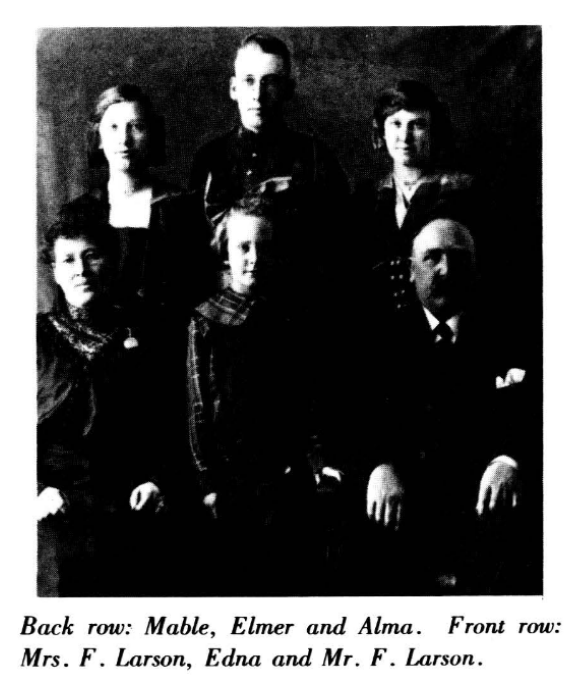
The business fell to Elmer's son Ted, who had in turn grown up working alongside his father in the store. Continuing the tradition Ted raised his own son, Rodney, in the business, and Rodney continues to manage Larson's to this day. Rodney's son, Lee, helps out around the store, continuing the story of this Provost institution.3
Endnotes
1. The First Peoples
1. Jack W. Brink, *Imagining Head-Smashed-In: Aboriginal Buffalo Hunting on the Northern Plains,* (Edmonton: Athabasca University Press, 2008), online.
2. "Bodo Archaeological Site & Centre," Bodo Archaeological Society, online.
2. Elevator Row
1. Senior Citizen's Club of Provost, *Early Furrows: A Story of Our Early Pioneers in Provost, Hayter, Bodo, Alberta and Surrounding Districts*, (1977), 67.
2. Senior Citizen's Club of Provost, "Provost 1908", *Early Furrows*, 1.
3. The Settlers
1. S. Dunbar, "Pioneering at Provost," *Early Furrows: A Story of Our Early Pioneers in Provost, Hayter, Bodo, Alberta and Surrounding Districts*, (1977), 3.
2. Howard Palmer, *Alberta: A New History*, (Toronto: McClelland & Stewart, 1999), 83.
3. Palmer, 91.
4. Palmer, 134.
4. Pioneering in Provost
1. Dunbar, *Early Furrows*, 3.
2. Dunbar, *Early Furrows*, 4.
3. Senior Citizen's Club of Provost, *Early Furrows*, 67.
5. Planning a Town
1. Pierre Berton, *The Promised Land,* (Toronto: McClelland & Stewart, 1984), 323.
2. Berton, 323.
3. Eleanor (Carter) Campbell, "The Carter Family," *Early Furrows*, 204.
6. Cattle Ranching
1. Palmer, 125.
8. The Pioneer Store
1. Martha Brue, "Provost Pioneers," *Early Furrows*, 8-9.
9. Having Fun
1. Stan Watson, "Report on Provost School District," *Early Furrows,* 43.
2. Edna (Larson) Work, "The Larson Family," *Early Furrows*, 23.
10. Churchgoing
1. Senior Citizen's Club of Provost, *Early Furrows*, 54-65.
2. Palmer, 103.
3. Statistics Canada, "Provost, Town [Census subdivision]", *Census Profile, 2021 Census of Population*, online.
11. Education
1. Senior Citizen's Club of Provost, *Early Furrows*, 1.
2. Stan Watson, "Report on Provost School District," *Early Furrows,* 40.
12. Community Spirit
1. Palmer, 128.
2. Palmer, 105.
13. Larson's Hardware
1. Senior Citizen's Club of Provost, *Early Furrows*, 128.
2. Edna (Larson) Work, "The Larson Family," *Early Furrows,* 22-24.
3. Larson's Hardware, "Our History," online.
Bibliography
Senior Citizen's Club of Provost. *Early Furrows: A Story of Our Early Pioneers in Provost, Hayter, Bodo, Alberta and Surrounding Districts*. 1977.
Berton, Pierre. *The Promised Land.* Toronto: McClelland & Stewart, 1984.
Brink, Jack W. *Imagining Head-Smashed-In: Aboriginal Buffalo Hunting on the Northern Plains.* Edmonton: Athabasca University Press, 2008. https://read.aupress.ca/read/34e373b7-02f1-4bf8-b855-98932988ff93/section/5b62a218-84bd-42b1-b9df-f8bbd348afca#ch01
Bodo Archaeological Society. "Bodo Archaeological Site & Centre." https://bodoarchaeology.com/
Larson's Hardware, "Our History." https://www.provostnews.ca/homehardware/history.html
Palmer, Howard. *Alberta: A New History*. Toronto: McClelland & Stewart, 1999.
Statistics Canada. "Census Profile, 2021 Census of Population." " https://www12.statcan.gc.ca/census-recensement/2021/dp-pd/prof/details/page.cfm?Lang=E&SearchText=provost&GENDERlist=1,2,3&STATISTIClist=1&DGUIDlist=2021A00054807002&HEADERlist=0



